-
Out of stock
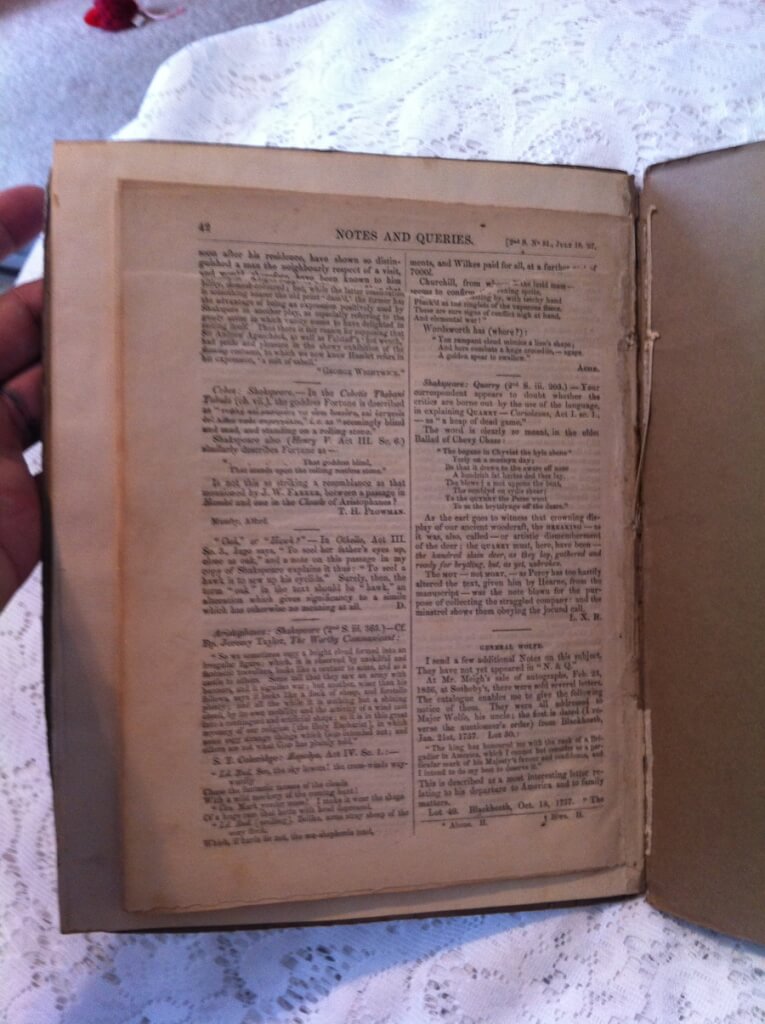
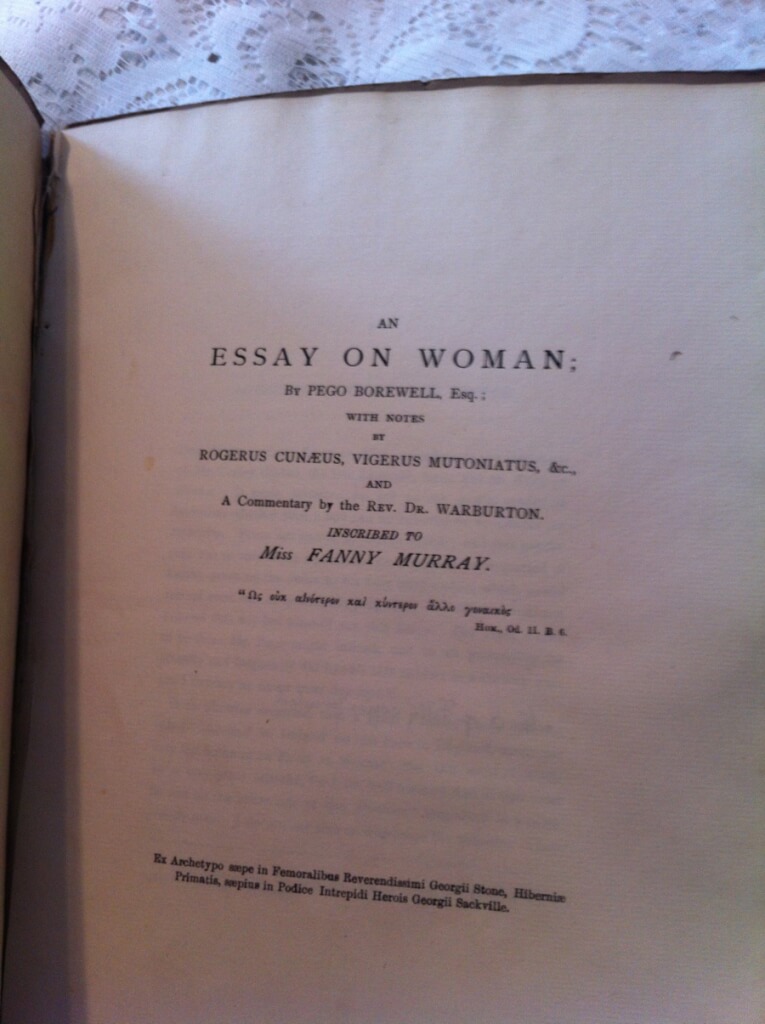 An Essay on Woman, by Pego Borewell, Esq., "with notes by Rogerus Cuneaus, Vigerus Mutoniatus, & Co. and A Commentary by the Rev. Dr. Warburton, inscribed to Miss Fanny Murray (np, bibliography on last page dated 1883) 7.5" X 9.75", 24pp., original soft wraps appear to be enclosed in brown wrap, appear to be two pages cut out before the title page, articles from "Notes and Queries" (dating July 11, 1857 and July 18, 1857) pasted into back of the book, followed by notes on legal paper from previous owner presumably trying to verify this edition Sometime in 1755, John Wilkes, together with fellow rake and son of the Archbishop of Cantebury, Thomas Potter (c. 1718-1759), composed a bawdy set of parodied Alexander Pope poems entitled An Essay on Woman, a satirical imitation of Pope's An Essay on Man. In 1763 he was put in jail for political reasons ("seditious libel for his anti-Jacobite smearing which appeared in his 'radical' weekly publication"). Upon release, his home was unlawfully searched and proofs of his "Essay on Woman" was discovered. This is an unknown reprint, as no original is known. I am still researching.
An Essay on Woman, by Pego Borewell, Esq., "with notes by Rogerus Cuneaus, Vigerus Mutoniatus, & Co. and A Commentary by the Rev. Dr. Warburton, inscribed to Miss Fanny Murray (np, bibliography on last page dated 1883) 7.5" X 9.75", 24pp., original soft wraps appear to be enclosed in brown wrap, appear to be two pages cut out before the title page, articles from "Notes and Queries" (dating July 11, 1857 and July 18, 1857) pasted into back of the book, followed by notes on legal paper from previous owner presumably trying to verify this edition Sometime in 1755, John Wilkes, together with fellow rake and son of the Archbishop of Cantebury, Thomas Potter (c. 1718-1759), composed a bawdy set of parodied Alexander Pope poems entitled An Essay on Woman, a satirical imitation of Pope's An Essay on Man. In 1763 he was put in jail for political reasons ("seditious libel for his anti-Jacobite smearing which appeared in his 'radical' weekly publication"). Upon release, his home was unlawfully searched and proofs of his "Essay on Woman" was discovered. This is an unknown reprint, as no original is known. I am still researching. -
 L'histoire comique de Francion en laquelle sont découvertes les plus subtiles finesses et trompeuses inventions tant des hommes que des femmes de toute sortes de conditions et d'âges. Non moins profitable pour s'en garder, que plaisante à la lecture., Charles Sorel, illus. Martin van Maele (chez Jean Fort, Paris, 1925 #131/ 1100 of copies made with pure Enoshima fibre paper) 9″x6″, 411pp, quarter-bound calf over slate boards, 5 raised bands, gilt titles and decorations on spine, top-edge gilt others deckled, fair condition, boards very loose, barely holding Charles Sorel, sieur de Souvigny (1602 –1674) was a French novelist and general writer. Very little is known of his life except that in 1635 he was historiographer of France. He wrote on science, history and religion, but is only remembered for his novels. He tried to destroy the vogue for the pastoral romance by writing a novel of adventure, the Histoire comique de Francion (first edition in seven volumes, 1623; second edition in twelve volumes, 1633). The episodical adventures of Francion found many readers, who nevertheless kept their admiration for Honoré d'Urfé's L'Astrée, which it was intended to ridicule.
L'histoire comique de Francion en laquelle sont découvertes les plus subtiles finesses et trompeuses inventions tant des hommes que des femmes de toute sortes de conditions et d'âges. Non moins profitable pour s'en garder, que plaisante à la lecture., Charles Sorel, illus. Martin van Maele (chez Jean Fort, Paris, 1925 #131/ 1100 of copies made with pure Enoshima fibre paper) 9″x6″, 411pp, quarter-bound calf over slate boards, 5 raised bands, gilt titles and decorations on spine, top-edge gilt others deckled, fair condition, boards very loose, barely holding Charles Sorel, sieur de Souvigny (1602 –1674) was a French novelist and general writer. Very little is known of his life except that in 1635 he was historiographer of France. He wrote on science, history and religion, but is only remembered for his novels. He tried to destroy the vogue for the pastoral romance by writing a novel of adventure, the Histoire comique de Francion (first edition in seven volumes, 1623; second edition in twelve volumes, 1633). The episodical adventures of Francion found many readers, who nevertheless kept their admiration for Honoré d'Urfé's L'Astrée, which it was intended to ridicule. -
 Die Abenteuer des Chevalier Faublas | Erzählt von Louvet de Couvray [[The adventures of the Chevalier Faublas | Told by Louvet de Couvray], etchings by Karl Walser (Georg Müller, Munich, 1910, #1411/1500) 8.25"x5.5", 4 volumes, x+216pp, 279pp, 295pp, 344pp, half calf over decorated silk (from a drawing by Karl Walser), black title and vol. label with gilt lettering and decorations on spine, 4 etched title vignettes and 12 toned etchings by Karl Walser on 12 panels with green tissue guard, ribbons present in all volumes, good+ condition. Karl Walser (1877-1943) was a Swiss painter, set designer and illustrator. His artwork, although very popular during his lifetime, has mostly been forgotten by the art world, unlike his brother, author Robert Walser, who was never able to support himself through writing which gained notoriety after his death. Jean-Baptiste Louvet de Couvrai (1760 - 1797) was born in Paris as the son of a stationer, he became a bookseller's clerk, and first attracted attention with the first part of his novel "Les Amours du chevalier de Faublas" (5 parts) in 1787; it was followed in 1788 by "Six semaines de la vie du chevalier de Faublas" (8 parts) and in 1790 by "La Fin des amours du chevalier de Faublas" (6 parts). The heroine, Lodoiska, was modeled on the wife of a jeweler in the Palais Royal, with whom he had an affair. She divorced her husband in 1792 and married Louvet in 1793. This is considered a so-called "libertine" novel. It dwells mainly on the sexual escapades of its hero, a sort of amiable young libertine, and on the corrupted morals of eighteenth-century France. At the start of this novel the young Chevalier de Faublas attends a party dressed as a woman and is knowingly seduced by the lady of the house ('. I receive with equal astonishment and pleasure a charming lesson, which I repeated more than once .') Oxford Comp. to French Literature says it is "typical of many frivolous, licentious novels of its time, and still mentioned. Faublas, the amiable hero, is the victim of his own charms. His amorous adventures, recounted with a certain lively force, begin with his entry into society at the age of sixteen. He loves several women by the way and three in particular. A jealous husband and a despairing suicide reduce the three to one. The novel ends on a moral note: Faublas , who had happened to settle down with his remaining love, is haunted by the avenging phantoms of the other two and goes mad."
Die Abenteuer des Chevalier Faublas | Erzählt von Louvet de Couvray [[The adventures of the Chevalier Faublas | Told by Louvet de Couvray], etchings by Karl Walser (Georg Müller, Munich, 1910, #1411/1500) 8.25"x5.5", 4 volumes, x+216pp, 279pp, 295pp, 344pp, half calf over decorated silk (from a drawing by Karl Walser), black title and vol. label with gilt lettering and decorations on spine, 4 etched title vignettes and 12 toned etchings by Karl Walser on 12 panels with green tissue guard, ribbons present in all volumes, good+ condition. Karl Walser (1877-1943) was a Swiss painter, set designer and illustrator. His artwork, although very popular during his lifetime, has mostly been forgotten by the art world, unlike his brother, author Robert Walser, who was never able to support himself through writing which gained notoriety after his death. Jean-Baptiste Louvet de Couvrai (1760 - 1797) was born in Paris as the son of a stationer, he became a bookseller's clerk, and first attracted attention with the first part of his novel "Les Amours du chevalier de Faublas" (5 parts) in 1787; it was followed in 1788 by "Six semaines de la vie du chevalier de Faublas" (8 parts) and in 1790 by "La Fin des amours du chevalier de Faublas" (6 parts). The heroine, Lodoiska, was modeled on the wife of a jeweler in the Palais Royal, with whom he had an affair. She divorced her husband in 1792 and married Louvet in 1793. This is considered a so-called "libertine" novel. It dwells mainly on the sexual escapades of its hero, a sort of amiable young libertine, and on the corrupted morals of eighteenth-century France. At the start of this novel the young Chevalier de Faublas attends a party dressed as a woman and is knowingly seduced by the lady of the house ('. I receive with equal astonishment and pleasure a charming lesson, which I repeated more than once .') Oxford Comp. to French Literature says it is "typical of many frivolous, licentious novels of its time, and still mentioned. Faublas, the amiable hero, is the victim of his own charms. His amorous adventures, recounted with a certain lively force, begin with his entry into society at the age of sixteen. He loves several women by the way and three in particular. A jealous husband and a despairing suicide reduce the three to one. The novel ends on a moral note: Faublas , who had happened to settle down with his remaining love, is haunted by the avenging phantoms of the other two and goes mad." -

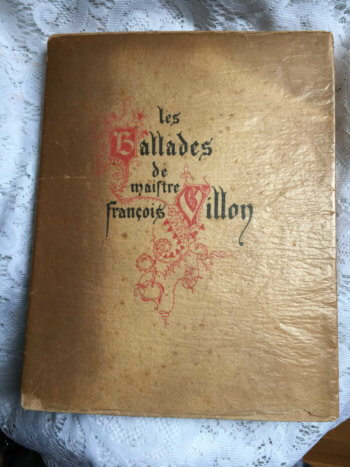 Les Ballades de Maistre Francois Villon, Francois Villon, illus. Chéri Hérouard, caligraphy ["escrites"] by Raymond de Rigné (chez Cres., Paris, 1919, #188/550 signed by Hérouard) 11.75" X 9.25", 169pp, original french wraps with glassine cover, 31 full page drawings by Hérouard plus 31 small vignette type illustrations. Beautifully printed on heavy deckle edged paper. good condition, all original, minor rubbing, slight foxing on outer pages, inner pages clean, rips in glassine cover at top and bottom of spine. François Villon (c. 1431_1464) was a French poet. Most of what is known about Villon has been gathered from legal records and gleaned from his own writings. He was a thief, killer, barroom brawler, and vagabond. He is perhaps best known for his Testaments and his Ballades. He was the most famous realist poet of the Middle Ages. Chéri Hérouard (1881 - 1961) was a French illustrator who was most famously known for his forty-five-year work for French society magazine, La Vie Parisienne. Under the pseudonym of Herric, he also created erotic and sadomasochistic illustrations for various books including the Kama Sutra.
Les Ballades de Maistre Francois Villon, Francois Villon, illus. Chéri Hérouard, caligraphy ["escrites"] by Raymond de Rigné (chez Cres., Paris, 1919, #188/550 signed by Hérouard) 11.75" X 9.25", 169pp, original french wraps with glassine cover, 31 full page drawings by Hérouard plus 31 small vignette type illustrations. Beautifully printed on heavy deckle edged paper. good condition, all original, minor rubbing, slight foxing on outer pages, inner pages clean, rips in glassine cover at top and bottom of spine. François Villon (c. 1431_1464) was a French poet. Most of what is known about Villon has been gathered from legal records and gleaned from his own writings. He was a thief, killer, barroom brawler, and vagabond. He is perhaps best known for his Testaments and his Ballades. He was the most famous realist poet of the Middle Ages. Chéri Hérouard (1881 - 1961) was a French illustrator who was most famously known for his forty-five-year work for French society magazine, La Vie Parisienne. Under the pseudonym of Herric, he also created erotic and sadomasochistic illustrations for various books including the Kama Sutra. -
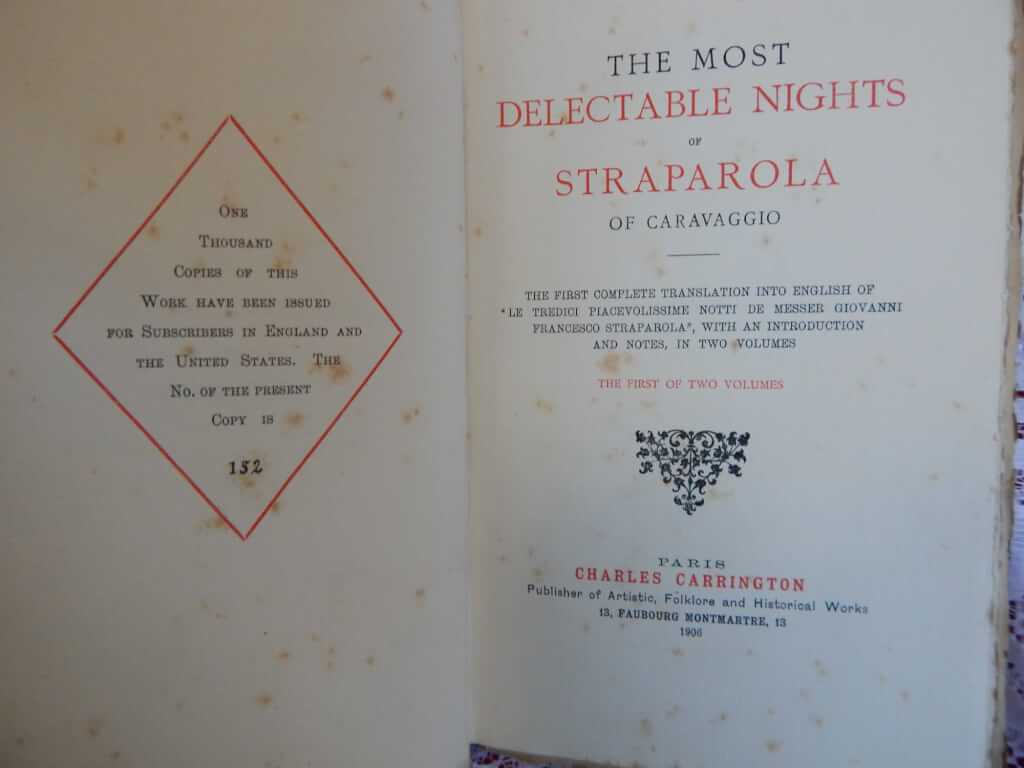
 The Most Delectable Nights of Straparola of Caravaggio, the first complete translation into english of "Le tredici piacevolissime notte, de Mesier Giovanni Francesco Straparola", with an introduction and notes, in two volumes, illust. by Léon Lebègue and Adolph Lambrecht (Charles Carrington, "Publisher of Artistic, Folklore and Historical Works", Paris, 1906, #152/1000, [first english translation, first edition] "Printed in Holland at the Printing Works of G. J. Thieme, Nymeguen.") 5.75"x8.5", 2 vol. xvi+352pp, xl+420pp, top edge gilt other edges deckled, blue boards with gilt borders and gilt lettering to the spines, red and black text and decorations throughout, numerous illustrations, both vignettes within text and tipped-in full color plates with descriptive tissue guards, handsome good+ copy for age, some foxing, small tear at top of vol. 1 spine, slight sunning to boards. This is a rare, beautifully executed, 1st edition, 1st English translation, 1st printing, low number limited edition, by Charles Carrington. Giovanni Francesco "Gianfrancesco" Straparola, also known as Zoan or Zuan Francesco Straparola da Caravaggio (1485?-1558) was a writer of poetry, and collector and writer of short stories. Some time during his life, he migrated from Caravaggio to Venice where he published a collection of stories in two volumes called Le piacevoli notti (1551 and 1553) (The Pleasant Nights, first translated by W. G. Waters in 1901 as "The Facetious Nights"). The Pleasant Nights is the work for which Straparola is most noted, and which contains a total of seventy-five short stories, fables, and fairy tales. The tales, or novelle, are divided into Nights, rather than chapters, and resemble the type of narrative presentation found in Boccaccio's Decameron. This presentation is of a gathering of Italian aristocrats, men and women, who entertain themselves by singing songs, dancing, telling stories and presenting enigmas (riddles). The Pleasant Nights contains many different types of tales, including realistic novellas, stories about practical jokes, tragic and triumphant love stories, bawdy tales, and animal stories. Some sixteen of these 74 tales are fairy tales including the story of Puss-in-Boots, the story of an impoverished boy whose enchanted cat earns him wealth, marriage to a princess, and a kingdom. Among the other fairy tales in The Pleasant Nights, we find a dragon slayer tale; the tale of a prince born in the shape of a pig due to a fairy’s curse who regains his human form only after marrying three time,; the story of Biancabella or “White Beauty” a princes who undergoes many trials until finally being saved by a fairy; and the a poor girl who acquire a magic doll that poops money and helps her marry a prince. It is claimed that many of the stories within The Pleasant Nights had been taken from earlier works, specifically from Girolamo Morlini, a 15th/16th century lawyer from Naples. If taken at his word, Straparola never denied this. In the Dedication at the front of the second volume, Straparola wrote that the stories ". . . written and collected in this volume [vol. 2 only?] are none of mine, but goods which I have feloniously taken from this man and that. Of a truth I confess they are not mine, and if I said otherwise I should lie, but nevertheless I have faithfully set them down according to the manner in which they were told by the ladies, nobles, learned men and gentlemen who gathered together for recreation."
The Most Delectable Nights of Straparola of Caravaggio, the first complete translation into english of "Le tredici piacevolissime notte, de Mesier Giovanni Francesco Straparola", with an introduction and notes, in two volumes, illust. by Léon Lebègue and Adolph Lambrecht (Charles Carrington, "Publisher of Artistic, Folklore and Historical Works", Paris, 1906, #152/1000, [first english translation, first edition] "Printed in Holland at the Printing Works of G. J. Thieme, Nymeguen.") 5.75"x8.5", 2 vol. xvi+352pp, xl+420pp, top edge gilt other edges deckled, blue boards with gilt borders and gilt lettering to the spines, red and black text and decorations throughout, numerous illustrations, both vignettes within text and tipped-in full color plates with descriptive tissue guards, handsome good+ copy for age, some foxing, small tear at top of vol. 1 spine, slight sunning to boards. This is a rare, beautifully executed, 1st edition, 1st English translation, 1st printing, low number limited edition, by Charles Carrington. Giovanni Francesco "Gianfrancesco" Straparola, also known as Zoan or Zuan Francesco Straparola da Caravaggio (1485?-1558) was a writer of poetry, and collector and writer of short stories. Some time during his life, he migrated from Caravaggio to Venice where he published a collection of stories in two volumes called Le piacevoli notti (1551 and 1553) (The Pleasant Nights, first translated by W. G. Waters in 1901 as "The Facetious Nights"). The Pleasant Nights is the work for which Straparola is most noted, and which contains a total of seventy-five short stories, fables, and fairy tales. The tales, or novelle, are divided into Nights, rather than chapters, and resemble the type of narrative presentation found in Boccaccio's Decameron. This presentation is of a gathering of Italian aristocrats, men and women, who entertain themselves by singing songs, dancing, telling stories and presenting enigmas (riddles). The Pleasant Nights contains many different types of tales, including realistic novellas, stories about practical jokes, tragic and triumphant love stories, bawdy tales, and animal stories. Some sixteen of these 74 tales are fairy tales including the story of Puss-in-Boots, the story of an impoverished boy whose enchanted cat earns him wealth, marriage to a princess, and a kingdom. Among the other fairy tales in The Pleasant Nights, we find a dragon slayer tale; the tale of a prince born in the shape of a pig due to a fairy’s curse who regains his human form only after marrying three time,; the story of Biancabella or “White Beauty” a princes who undergoes many trials until finally being saved by a fairy; and the a poor girl who acquire a magic doll that poops money and helps her marry a prince. It is claimed that many of the stories within The Pleasant Nights had been taken from earlier works, specifically from Girolamo Morlini, a 15th/16th century lawyer from Naples. If taken at his word, Straparola never denied this. In the Dedication at the front of the second volume, Straparola wrote that the stories ". . . written and collected in this volume [vol. 2 only?] are none of mine, but goods which I have feloniously taken from this man and that. Of a truth I confess they are not mine, and if I said otherwise I should lie, but nevertheless I have faithfully set them down according to the manner in which they were told by the ladies, nobles, learned men and gentlemen who gathered together for recreation." -
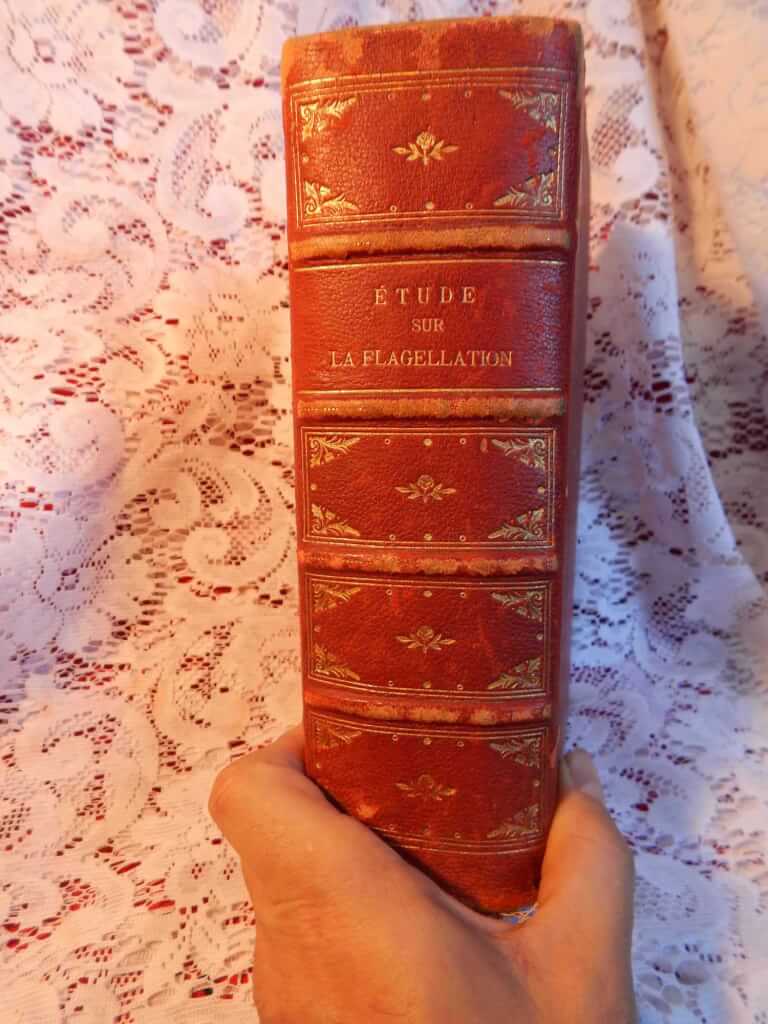
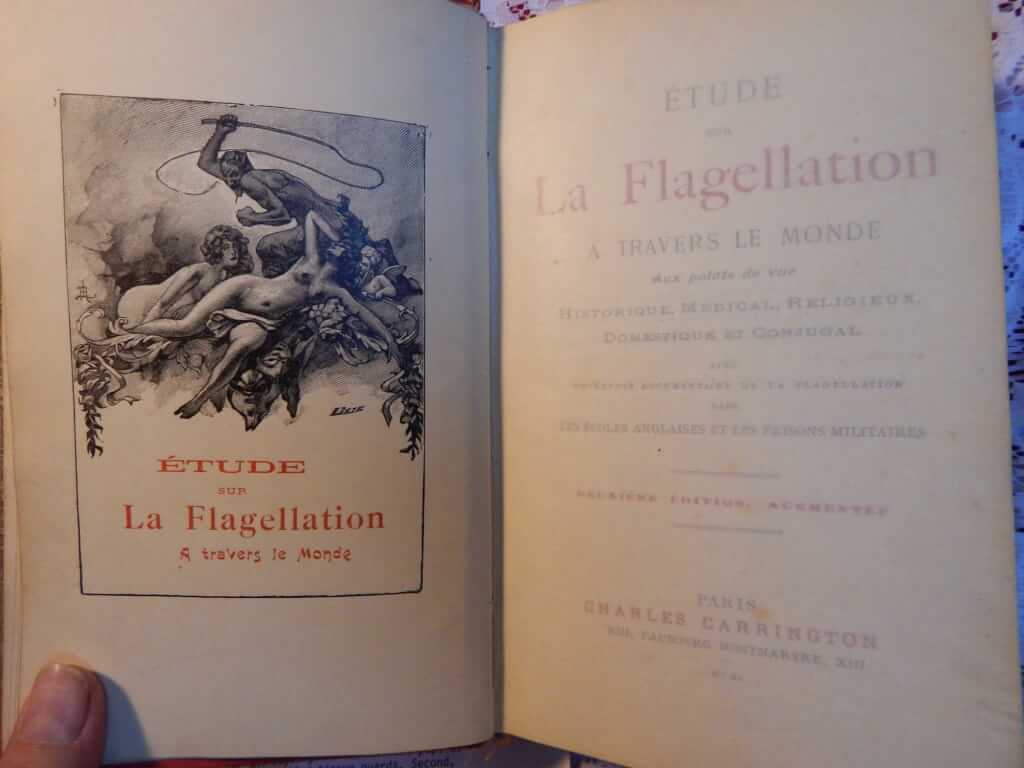 Étude sur La Flagellation a travers le monde aux points de vue Historique, Medical, Religieux, Domestique et Conjugal | avec un exposé documentaire de la flagellation dans Les écoles anglaises et les prisons militaires, Deuxiéme Édition, Augmentée [Study of the Flagellation throughout the world from the historical, medical, religious, domestic and marital points of view | with a documentary presentation of flogging in English Schools and Military Prisons, Second Edition, Augmented], by Jean de Villiot [pseud. most likely of Charles Carrington, Hugues Rebell and Hector France],illust. by René Lelong, (Charles Carrington, Paris, 1901, "Second Edition Augmented", printed by Achevé d'imprimer le 29 septembre 1900 par Em. Pivoteau. Imprimeur à Saint-Amand-Mont-Rond (Cher)) 5.5"x8.5", xxiv+646pp, quarter-bound in red morocco over red boards, 4 raised bands, gilt titles and decorations on spine, marbled paste-downs, all edges gilt, ribbon intact, binding frayed a bit at bottom, some rubbing and stains, otherwise very good condition for age, frontispiece and 20 B&W illustrations by René Lelong tipped in with titled tissue guards. This book is the compilation and expansion of a few other books previously published by Charles Carrington including the original Étude sur La Flagellation a travers le monde published in 1898. It represents a more complete representation of those writings beautifully bound into one book, covering studies on flogging through the centuries, flogging in England, flogging in the history of France (the cases of Madame Du Barry, the Marquise de Rosen.), the flogging from the medical point of view where one learns its healing properties, flogging in literature or the art of using it for pleasure, the discipline to school and domestic and spousal corrections, and "in our current society". Jean de Villiot is a pseudonym frequently used by Carrington and the various authors he relied upon, especially for works that involved flagellation. The illustrator, René Lelong was a third class medalist at the Salon des artistes français of 1895 which he became a member from 1898. He has produced advertising posters and illustrated numerous books and texts. He was a professor at the Julian Academy from 1879 to 1891.
Étude sur La Flagellation a travers le monde aux points de vue Historique, Medical, Religieux, Domestique et Conjugal | avec un exposé documentaire de la flagellation dans Les écoles anglaises et les prisons militaires, Deuxiéme Édition, Augmentée [Study of the Flagellation throughout the world from the historical, medical, religious, domestic and marital points of view | with a documentary presentation of flogging in English Schools and Military Prisons, Second Edition, Augmented], by Jean de Villiot [pseud. most likely of Charles Carrington, Hugues Rebell and Hector France],illust. by René Lelong, (Charles Carrington, Paris, 1901, "Second Edition Augmented", printed by Achevé d'imprimer le 29 septembre 1900 par Em. Pivoteau. Imprimeur à Saint-Amand-Mont-Rond (Cher)) 5.5"x8.5", xxiv+646pp, quarter-bound in red morocco over red boards, 4 raised bands, gilt titles and decorations on spine, marbled paste-downs, all edges gilt, ribbon intact, binding frayed a bit at bottom, some rubbing and stains, otherwise very good condition for age, frontispiece and 20 B&W illustrations by René Lelong tipped in with titled tissue guards. This book is the compilation and expansion of a few other books previously published by Charles Carrington including the original Étude sur La Flagellation a travers le monde published in 1898. It represents a more complete representation of those writings beautifully bound into one book, covering studies on flogging through the centuries, flogging in England, flogging in the history of France (the cases of Madame Du Barry, the Marquise de Rosen.), the flogging from the medical point of view where one learns its healing properties, flogging in literature or the art of using it for pleasure, the discipline to school and domestic and spousal corrections, and "in our current society". Jean de Villiot is a pseudonym frequently used by Carrington and the various authors he relied upon, especially for works that involved flagellation. The illustrator, René Lelong was a third class medalist at the Salon des artistes français of 1895 which he became a member from 1898. He has produced advertising posters and illustrated numerous books and texts. He was a professor at the Julian Academy from 1879 to 1891. -
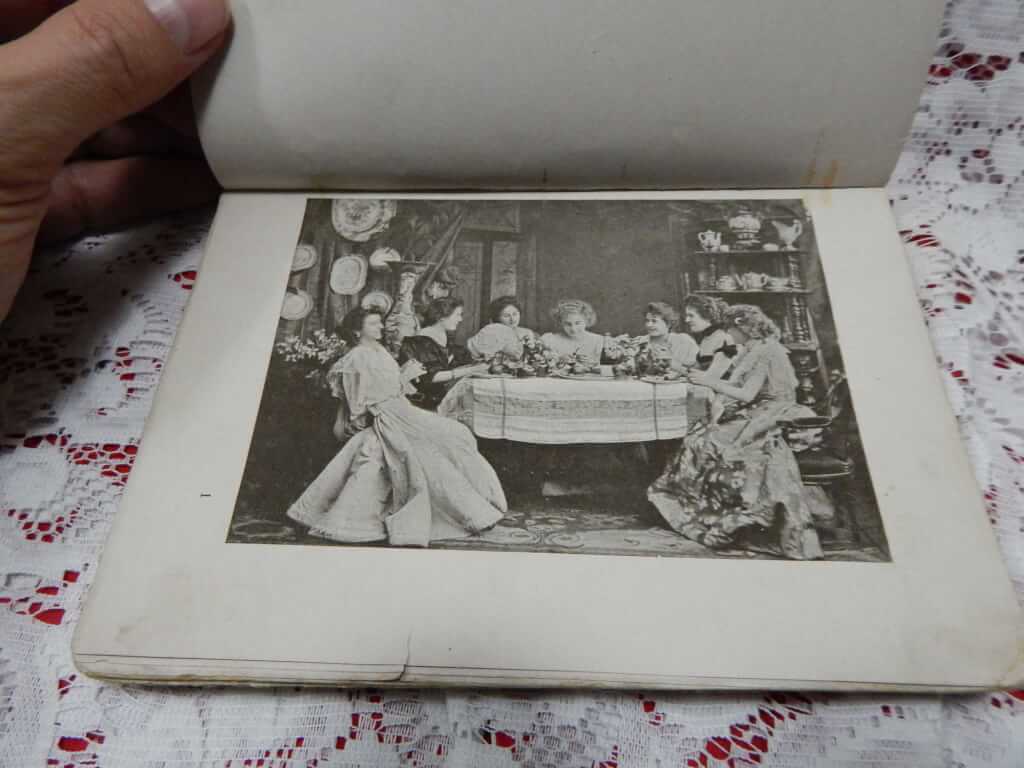
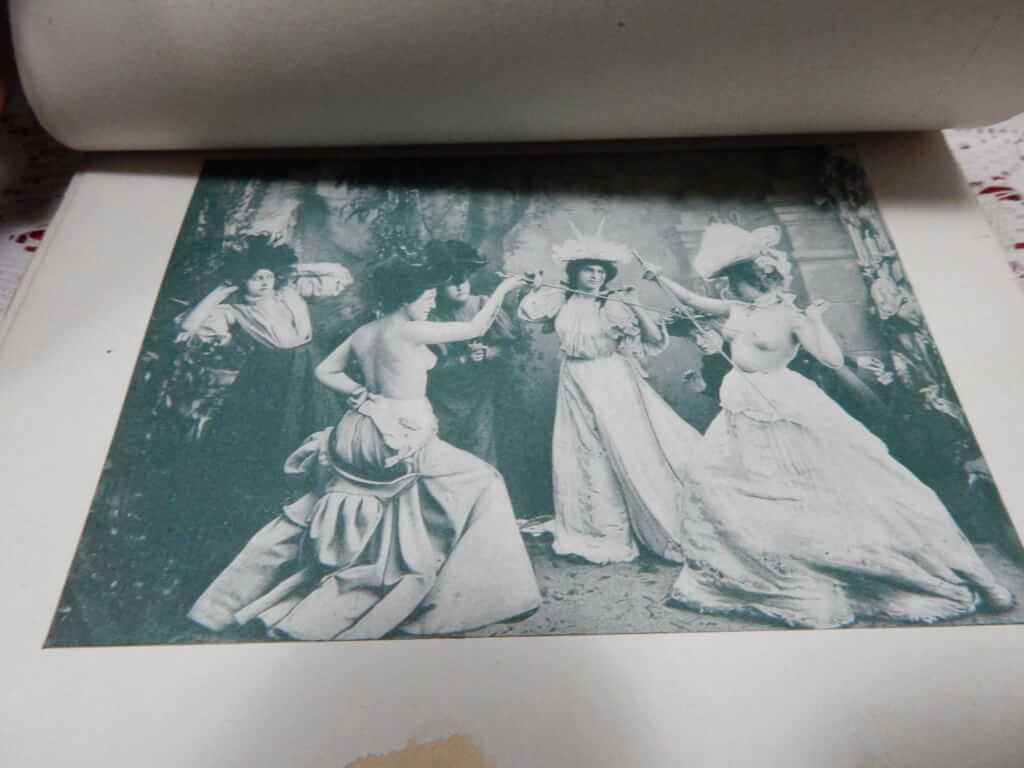 Photo Album (ca. 1900), 81 photos, 6 themed series: Le Duel (The Duel), La Deception (The Deception), Les Armurea (The Armor), La Soubrette (The Coy Soprano), Le Coucher (Going to Bed), Le Bain (The Bath), no date, no photographer, no publisher. 7.25" x 5.5", 87pp unpaginated, no boards, signatures with rivets (no longer holding) and taped together. 81 photos are grouped into 6 "photo stories". The only other marking is on the second photo and reads "SADAG, SW" The photos are elaborately staged photo. Each series starts out with the subject(s) fully clothed, but at some point becoming partially undressed. "SADAG" is "Société Anonyme des Arts Graphiques". According to books from England and France they were a "well known Geneva firm of photo engravers". The marking on the photo could mean that the the photos were processed by a member of this organization or it was processed using the techniques developed by this organization. Le Duel (14 photos) portrays a group of ladies at a lunch or tea. They start drinking and fight breaks out resulting in a duel. The duel is, of course, performed topless. In the end the winner consoles the loser. La Deception (15 photos) portrays a woman sitting in her parlor and her table is set for a two. She reads a letter/note which upsets her then angers her. She clears away the extra table setting and starts to drink wine. The more drunk she gets the less clothes she has on. In the last photo she is passed out and there are two cherubs flying around the room. In Les Armurea (11 photos) a woman is admiring two suits of armor. She undresses and puts on one of the suits of armor. La Soubrette (15 photos, roughly translated as "The Coy Soprano") a maid is cleaning up a woman's dressing room. She decides to play the soprano. She undresses, lets her hair down, uses the brush and puts on a fancy dress. Le Coucher (16 photos, "Going to Bed") is a photo story about a woman preparing for bed. Le Bain (10 photos, "The Bath") a woman prepares for and takes a bath.
Photo Album (ca. 1900), 81 photos, 6 themed series: Le Duel (The Duel), La Deception (The Deception), Les Armurea (The Armor), La Soubrette (The Coy Soprano), Le Coucher (Going to Bed), Le Bain (The Bath), no date, no photographer, no publisher. 7.25" x 5.5", 87pp unpaginated, no boards, signatures with rivets (no longer holding) and taped together. 81 photos are grouped into 6 "photo stories". The only other marking is on the second photo and reads "SADAG, SW" The photos are elaborately staged photo. Each series starts out with the subject(s) fully clothed, but at some point becoming partially undressed. "SADAG" is "Société Anonyme des Arts Graphiques". According to books from England and France they were a "well known Geneva firm of photo engravers". The marking on the photo could mean that the the photos were processed by a member of this organization or it was processed using the techniques developed by this organization. Le Duel (14 photos) portrays a group of ladies at a lunch or tea. They start drinking and fight breaks out resulting in a duel. The duel is, of course, performed topless. In the end the winner consoles the loser. La Deception (15 photos) portrays a woman sitting in her parlor and her table is set for a two. She reads a letter/note which upsets her then angers her. She clears away the extra table setting and starts to drink wine. The more drunk she gets the less clothes she has on. In the last photo she is passed out and there are two cherubs flying around the room. In Les Armurea (11 photos) a woman is admiring two suits of armor. She undresses and puts on one of the suits of armor. La Soubrette (15 photos, roughly translated as "The Coy Soprano") a maid is cleaning up a woman's dressing room. She decides to play the soprano. She undresses, lets her hair down, uses the brush and puts on a fancy dress. Le Coucher (16 photos, "Going to Bed") is a photo story about a woman preparing for bed. Le Bain (10 photos, "The Bath") a woman prepares for and takes a bath. -

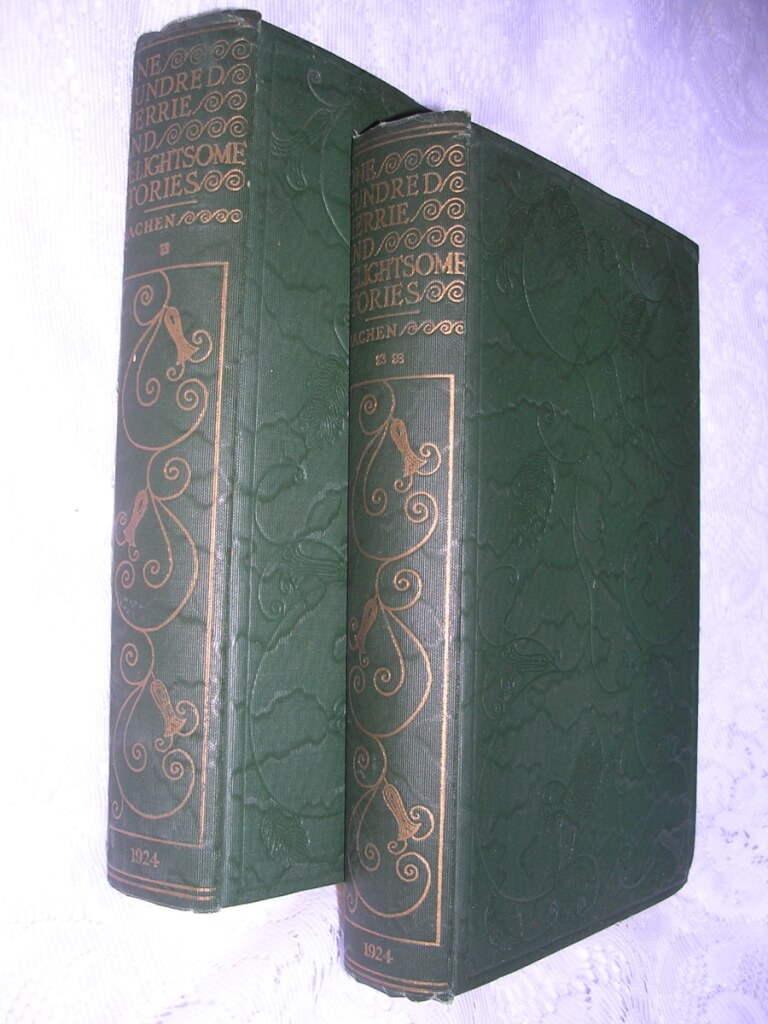 One Hundred Merrie and Delightsome Stories (Les Cent Nouvelles Nouvelles) (2 volumes), trans. Robert B. Douglas (Privately Printed for Subscribers only, Carbonnek, 1924, #591/1250) 8 7/8" X 5 3/4", 2 vol. 279pp 272pp, hardbound no DJ, dark green moire silk boards decorated in blind stamp, spines lettered and decorated in gilt, gilt top edge, other edges deckle, frontispiece signed by the artist, Clara Tice, very good condition, slight bumping on corners This is a two volume set of books beautifully bound and in excellent condition. Some pages remain uncut. A rare book in rare condition. It is signed by the artist, Clara Tice, under the frontispiece. It is illustrated with 16 full page drawings by Clara Tice. Purported a collection of short stories narrated by various persons at the court of Philippe le Bon, and collected together by Antoine de la Sale, the nouvelles are, according to the authority on French Literature—Professor George Saintsbury "undoubtedly the first work of literary prose in French ... The short prose tale of a comic character is the one French literary product the pre-eminence and perfection of which it is impossible to dispute, and the prose tale first appears to advantage in the Cent Nouvelles Nouvelles." The stories give a curious glimpses of life in the 15th century, providing a genuine view of the social condition of the nobility and the middle classes. M. Lenient, a French critic, says: "Generally the incidents and personages belong to the bourgeoisée; there is nothing chivalric, nothing wonderful; no dreamy lovers, romantic dames, fairies, or enchanters. Noble dames, bourgeois, nuns, knights, merchants, monks, and peasants mutually dupe each other. The lord deceives the miller's wife by imposing on her simplicity, and the miller retaliates in much the same manner. The shepherd marries the knight's sister, and the nobleman is not over scandalized. The vices of the monks are depicted in half a score tales, and the seducers are punished with a severity not always in proportion to the offence." For four centuries 10 of the stories were credited to Louis XI. Modern scholars have since ascribed them to either Philippe le Bel or Comte de Charolais. In all, some thirty-two noblemen or squires contributed the stories, with some 14 or 15 taken from Giovanni Boccaccio, and as many more from Gian Francesco Poggio Bracciolini or other Italian writers, or French fabliaux, but about 70 of them appear to be original.
One Hundred Merrie and Delightsome Stories (Les Cent Nouvelles Nouvelles) (2 volumes), trans. Robert B. Douglas (Privately Printed for Subscribers only, Carbonnek, 1924, #591/1250) 8 7/8" X 5 3/4", 2 vol. 279pp 272pp, hardbound no DJ, dark green moire silk boards decorated in blind stamp, spines lettered and decorated in gilt, gilt top edge, other edges deckle, frontispiece signed by the artist, Clara Tice, very good condition, slight bumping on corners This is a two volume set of books beautifully bound and in excellent condition. Some pages remain uncut. A rare book in rare condition. It is signed by the artist, Clara Tice, under the frontispiece. It is illustrated with 16 full page drawings by Clara Tice. Purported a collection of short stories narrated by various persons at the court of Philippe le Bon, and collected together by Antoine de la Sale, the nouvelles are, according to the authority on French Literature—Professor George Saintsbury "undoubtedly the first work of literary prose in French ... The short prose tale of a comic character is the one French literary product the pre-eminence and perfection of which it is impossible to dispute, and the prose tale first appears to advantage in the Cent Nouvelles Nouvelles." The stories give a curious glimpses of life in the 15th century, providing a genuine view of the social condition of the nobility and the middle classes. M. Lenient, a French critic, says: "Generally the incidents and personages belong to the bourgeoisée; there is nothing chivalric, nothing wonderful; no dreamy lovers, romantic dames, fairies, or enchanters. Noble dames, bourgeois, nuns, knights, merchants, monks, and peasants mutually dupe each other. The lord deceives the miller's wife by imposing on her simplicity, and the miller retaliates in much the same manner. The shepherd marries the knight's sister, and the nobleman is not over scandalized. The vices of the monks are depicted in half a score tales, and the seducers are punished with a severity not always in proportion to the offence." For four centuries 10 of the stories were credited to Louis XI. Modern scholars have since ascribed them to either Philippe le Bel or Comte de Charolais. In all, some thirty-two noblemen or squires contributed the stories, with some 14 or 15 taken from Giovanni Boccaccio, and as many more from Gian Francesco Poggio Bracciolini or other Italian writers, or French fabliaux, but about 70 of them appear to be original. -
Out of stock
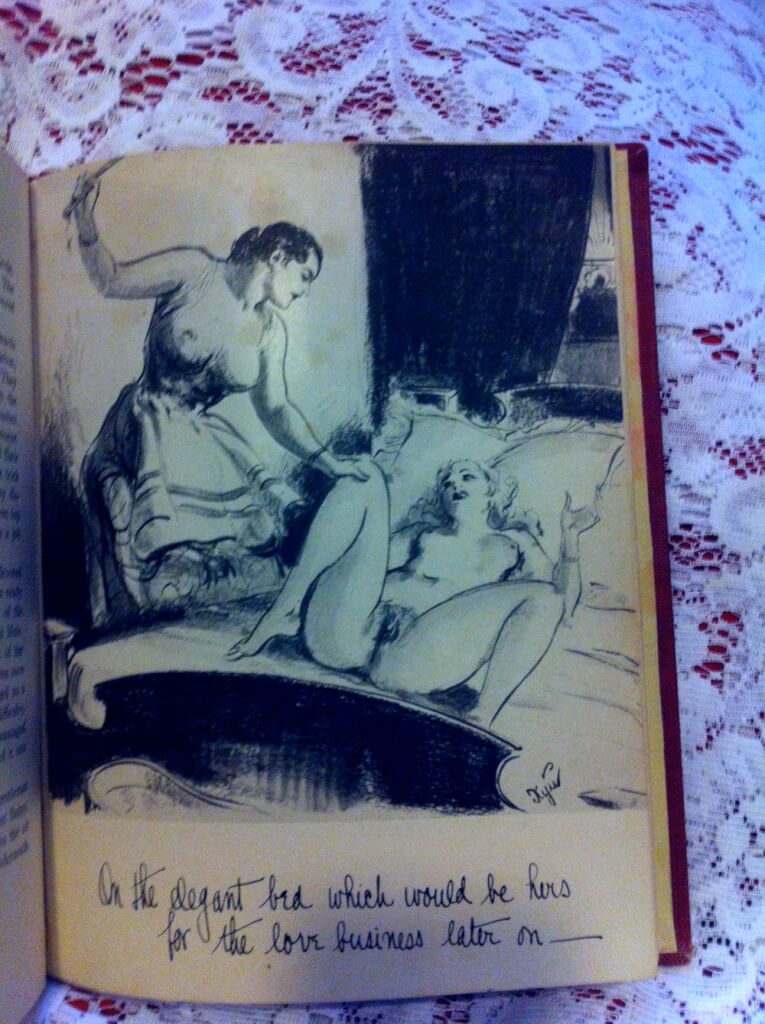
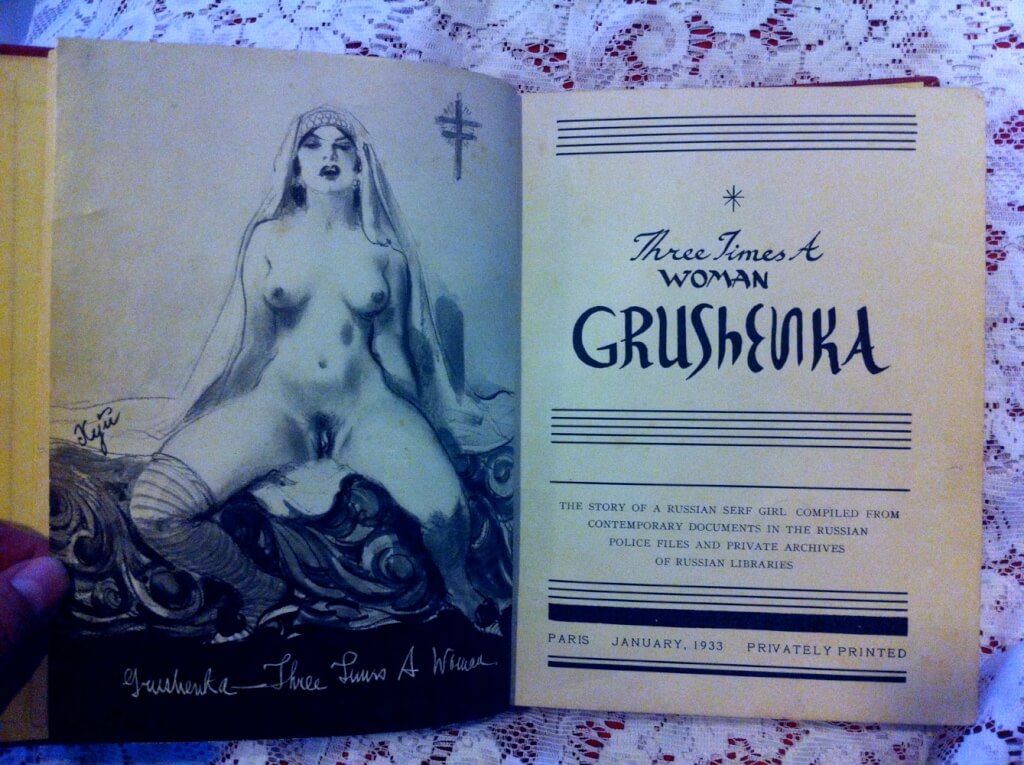 Three Times a Woman, Grushenka, anonymous [possibly Val Lewton?], illus. "a young Russian residing in Paris, who unfortunately must remain anonymous" (Privately Printed, London [New York], 1933) 9" X 7", 252pp, hardbound no DJ, red boards with gilt title on spine, good condition, minor wear and bumping, anonymous bookplate with the profile of a man made from many copulating couples. Title page reads: "The Story of a Russian Serf Girl Compiled from Contemporary Documents in the Russian Police Files and Private Archives of Russian Libraries" Originally published at New York in 1933 with a false Paris imprint. Val Lewton, the supposed author, was a well known film producer, responsible for a series of good low-budget horror movies in the 1940's by such directors as Robert Wise, Mark Robson and Jacques Tourneur. The book purports to be a flaggelation story written by a Russian living in Paris and then translated to english. The story takes place c. 1728, "shortly after the death of Peter the Great". The main character is Grushenka Pavlovsk. This edition is complete with very explicit illustrations.
Three Times a Woman, Grushenka, anonymous [possibly Val Lewton?], illus. "a young Russian residing in Paris, who unfortunately must remain anonymous" (Privately Printed, London [New York], 1933) 9" X 7", 252pp, hardbound no DJ, red boards with gilt title on spine, good condition, minor wear and bumping, anonymous bookplate with the profile of a man made from many copulating couples. Title page reads: "The Story of a Russian Serf Girl Compiled from Contemporary Documents in the Russian Police Files and Private Archives of Russian Libraries" Originally published at New York in 1933 with a false Paris imprint. Val Lewton, the supposed author, was a well known film producer, responsible for a series of good low-budget horror movies in the 1940's by such directors as Robert Wise, Mark Robson and Jacques Tourneur. The book purports to be a flaggelation story written by a Russian living in Paris and then translated to english. The story takes place c. 1728, "shortly after the death of Peter the Great". The main character is Grushenka Pavlovsk. This edition is complete with very explicit illustrations. -
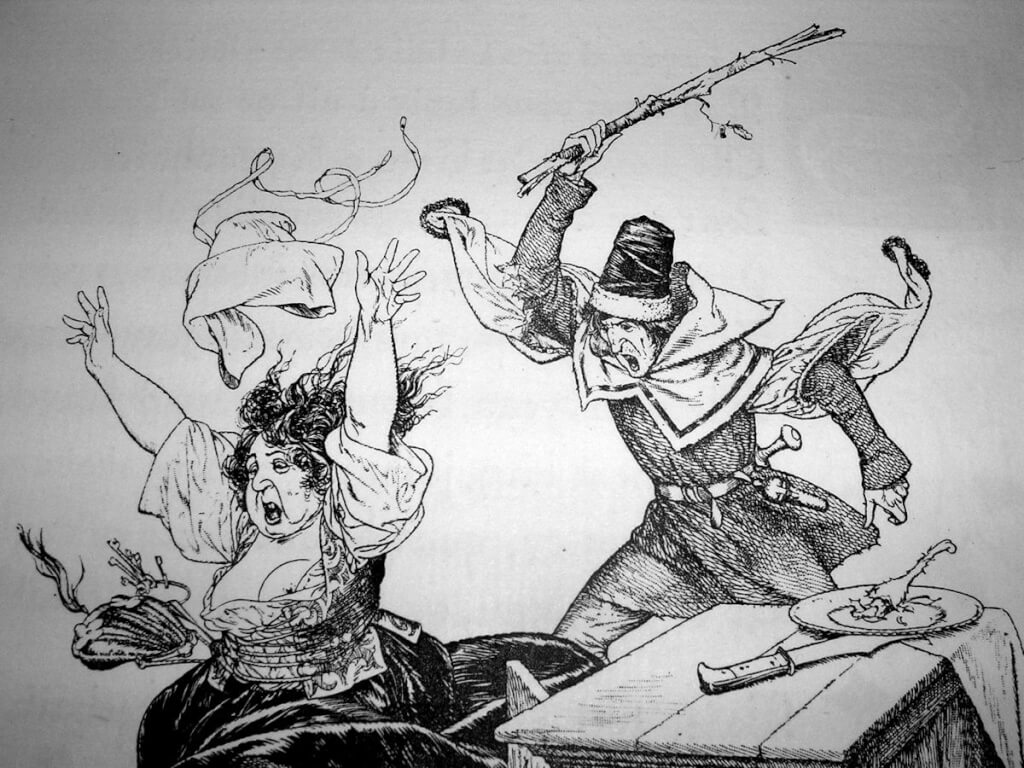
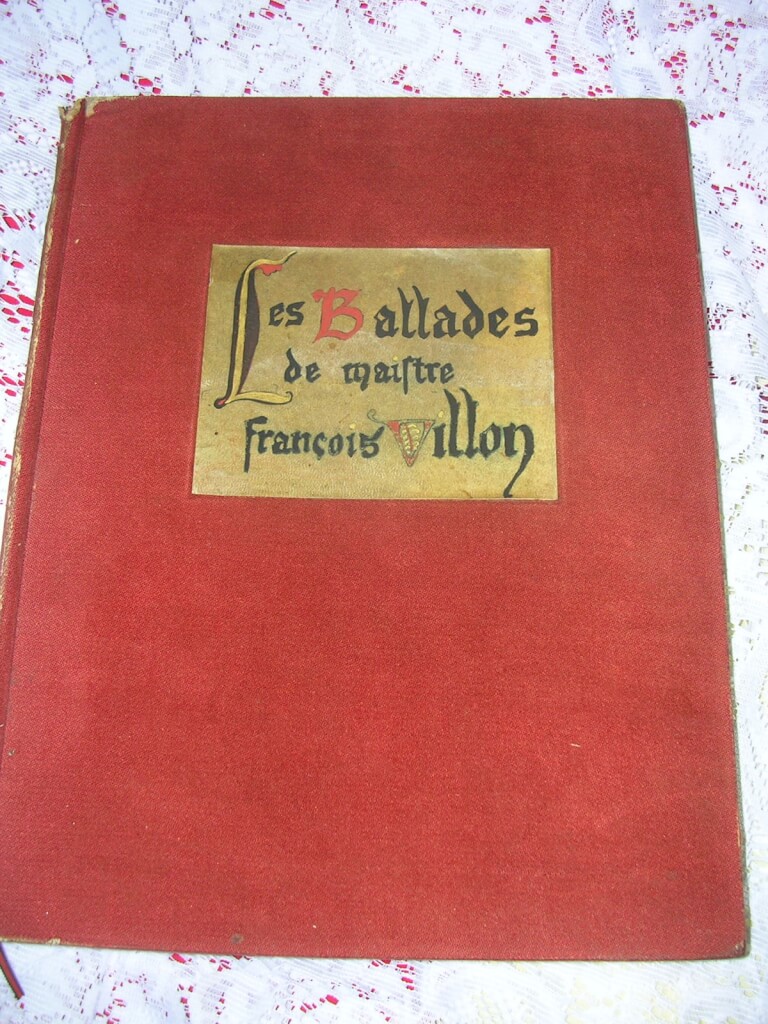 Les Ballades de Maistre Francois Villon, Francois Villon, illus. Chéri Hérouard, caligraphy ["escrites"] by Raymond de Rigné (chez Cres., Paris, 1919) 11.75" X 9.25", 169pp, rebound in red cloth boards with paper labels, decorated end papers. Original soft wraps intact. #450/550 signed by Hérouard. 31 full page drawings by Hérouard plus 31 small vignette type illustrations with a few "signed" by him. Beautifully printed on heavy deckle edged paper. good condition, wear to top and bottom of spine. ribbon intact. François Villon (c. 1431_1464) was a French poet. Most of what is known about Villon has been gathered from legal records and gleaned from his own writings. He was a thief, killer, barroom brawler, and vagabond. He is perhaps best known for his Testaments and his Ballades. He was the most famous realist poet of the Middle Ages. Chéri Hérouard (1881 - 1961) was a French illustrator who was most famously known for his forty-five-year work for French society magazine, La Vie Parisienne. Under the pseudonym of Herric, he also created erotic and sadomasochistic illustrations for various books including the Kama Sutra. This work was originally published with soft wraps. This copy has been beautifully rebound with it's original wraps intact.
Les Ballades de Maistre Francois Villon, Francois Villon, illus. Chéri Hérouard, caligraphy ["escrites"] by Raymond de Rigné (chez Cres., Paris, 1919) 11.75" X 9.25", 169pp, rebound in red cloth boards with paper labels, decorated end papers. Original soft wraps intact. #450/550 signed by Hérouard. 31 full page drawings by Hérouard plus 31 small vignette type illustrations with a few "signed" by him. Beautifully printed on heavy deckle edged paper. good condition, wear to top and bottom of spine. ribbon intact. François Villon (c. 1431_1464) was a French poet. Most of what is known about Villon has been gathered from legal records and gleaned from his own writings. He was a thief, killer, barroom brawler, and vagabond. He is perhaps best known for his Testaments and his Ballades. He was the most famous realist poet of the Middle Ages. Chéri Hérouard (1881 - 1961) was a French illustrator who was most famously known for his forty-five-year work for French society magazine, La Vie Parisienne. Under the pseudonym of Herric, he also created erotic and sadomasochistic illustrations for various books including the Kama Sutra. This work was originally published with soft wraps. This copy has been beautifully rebound with it's original wraps intact. -
 Pudeur [Modesty], André Billy (Jean Vigneau, éditeur, 1946 [Philadelphia?] limited edition #61/450 first edition) 9.5″ X 11.25″, 97pp, original state, unbound loose signature, soft wraps enclosed in a cream & green loose hardcover which fits into a slipcase, some very slight foxing on wraps and slipcase but otherwise a very clean copy, small rip at bottom of spine. André Billy (1882 - 1971) was a French writer. He was born in Saint-Quentin, Aisne. After completing secondary studies at the Collège de la Providence in Amiens, he studied under the Jesuits at Saint-Dizier. He began writing in 1907, occasionally using the pseudonym Jean de l'Escritoire. Billy used ecclesiastical settings for the novels Bénoni, L'Approbaniste, Introïbo, and Le Narthex. He was inspired by the story-tellers of the 18th for the essay Pudeur and a few other works. For many years he was the literary critic for L'Œuvre. He edited the collection Leurs Raisons. Billy became honorary president of the Société des amis de Philéas Lebesgue. Retiring to Lyon during the Occupation of France, he worked on a series of imposing biographies: Vie de Balzac, Vie de Diderot, and Vie de Sainte-Beuve. He was elected to the Académie Goncourt in 1943, but could not take his seat until 1944 because of the hostility of several members, some of whom he had criticised in his writings. After the War, he wrote the Chroniques du samedi for Le Figaro littéraire. The collection Histoire de la vie littéraire (éditions Tallandier) was published under the direction of André Billy, who contributed L'Époque 1900. In total, during his career he was to write 11,000 articles for over one hundred European newspapers.
Pudeur [Modesty], André Billy (Jean Vigneau, éditeur, 1946 [Philadelphia?] limited edition #61/450 first edition) 9.5″ X 11.25″, 97pp, original state, unbound loose signature, soft wraps enclosed in a cream & green loose hardcover which fits into a slipcase, some very slight foxing on wraps and slipcase but otherwise a very clean copy, small rip at bottom of spine. André Billy (1882 - 1971) was a French writer. He was born in Saint-Quentin, Aisne. After completing secondary studies at the Collège de la Providence in Amiens, he studied under the Jesuits at Saint-Dizier. He began writing in 1907, occasionally using the pseudonym Jean de l'Escritoire. Billy used ecclesiastical settings for the novels Bénoni, L'Approbaniste, Introïbo, and Le Narthex. He was inspired by the story-tellers of the 18th for the essay Pudeur and a few other works. For many years he was the literary critic for L'Œuvre. He edited the collection Leurs Raisons. Billy became honorary president of the Société des amis de Philéas Lebesgue. Retiring to Lyon during the Occupation of France, he worked on a series of imposing biographies: Vie de Balzac, Vie de Diderot, and Vie de Sainte-Beuve. He was elected to the Académie Goncourt in 1943, but could not take his seat until 1944 because of the hostility of several members, some of whom he had criticised in his writings. After the War, he wrote the Chroniques du samedi for Le Figaro littéraire. The collection Histoire de la vie littéraire (éditions Tallandier) was published under the direction of André Billy, who contributed L'Époque 1900. In total, during his career he was to write 11,000 articles for over one hundred European newspapers. -
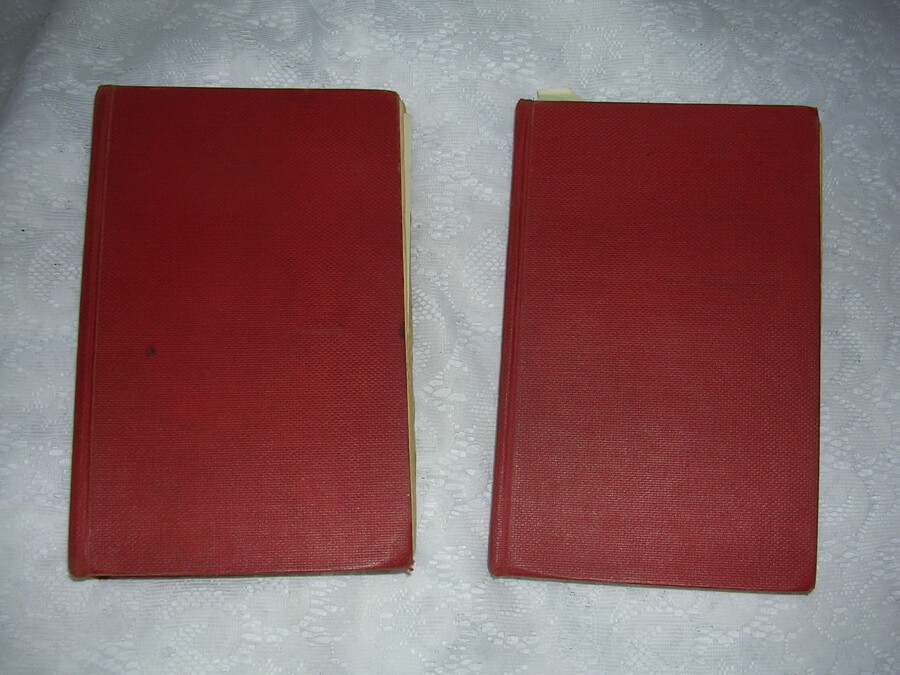
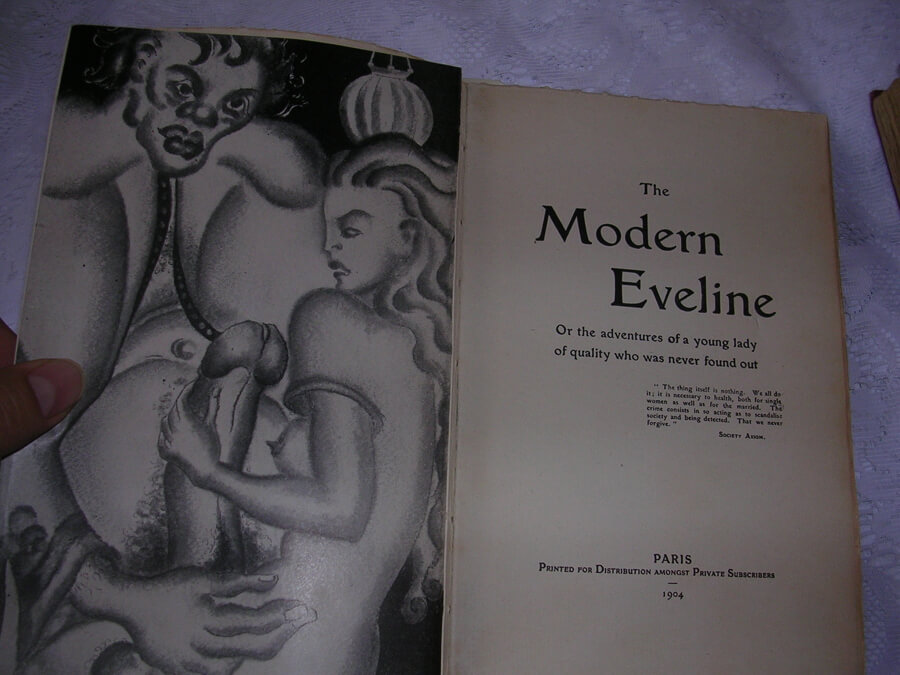 The Modern Eveline; or the adventures of a young lady of quality who was never found out (2 volumes), anonymous (Printed for Distribution Amongst Private Subscribers, Paris, 1904 [Miller Brothers, New York, c. 1930]) 9 1/8" X 6 7/8", 2 vol. 322pp 222pp, hardbound no DJ, plain blank red cloth boards and spine, deckle edges, fair condition, boards almost separated in volume one, boards loose in volume 2 but attached, frontispiece unattached. First American Edition. Turn of the 20th century erotic adaptation by notorious publisher Charles Carrington of a ca.1840 galante novel, Evelina, that, according to Mendes, was explicitly sexed-up by one of Carrington's staff hacks. This edition, containing the full text to the Carrington three-volume edition, was issued in the early 1930s by the Miller Brothers who were part of New York City's clandestine erotica scene along with Sam Roth, Esar Levine, and Ben Rebhuhn. Very graphic and explicite illustrations from an anonymous 1930's artist.
The Modern Eveline; or the adventures of a young lady of quality who was never found out (2 volumes), anonymous (Printed for Distribution Amongst Private Subscribers, Paris, 1904 [Miller Brothers, New York, c. 1930]) 9 1/8" X 6 7/8", 2 vol. 322pp 222pp, hardbound no DJ, plain blank red cloth boards and spine, deckle edges, fair condition, boards almost separated in volume one, boards loose in volume 2 but attached, frontispiece unattached. First American Edition. Turn of the 20th century erotic adaptation by notorious publisher Charles Carrington of a ca.1840 galante novel, Evelina, that, according to Mendes, was explicitly sexed-up by one of Carrington's staff hacks. This edition, containing the full text to the Carrington three-volume edition, was issued in the early 1930s by the Miller Brothers who were part of New York City's clandestine erotica scene along with Sam Roth, Esar Levine, and Ben Rebhuhn. Very graphic and explicite illustrations from an anonymous 1930's artist. -
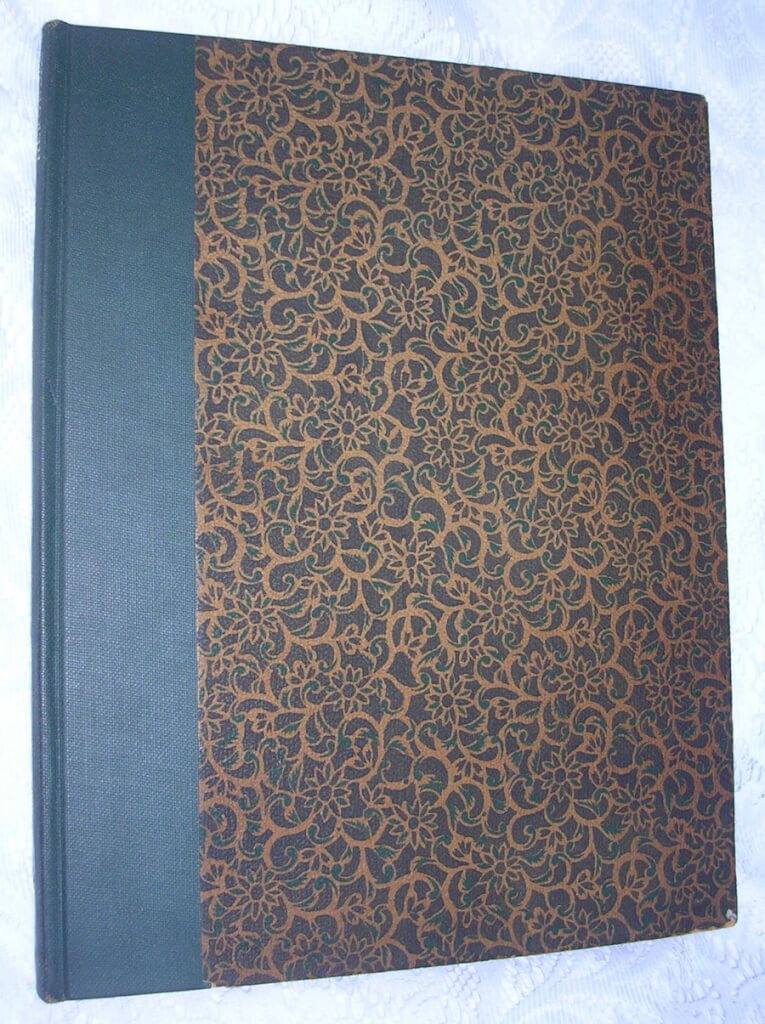
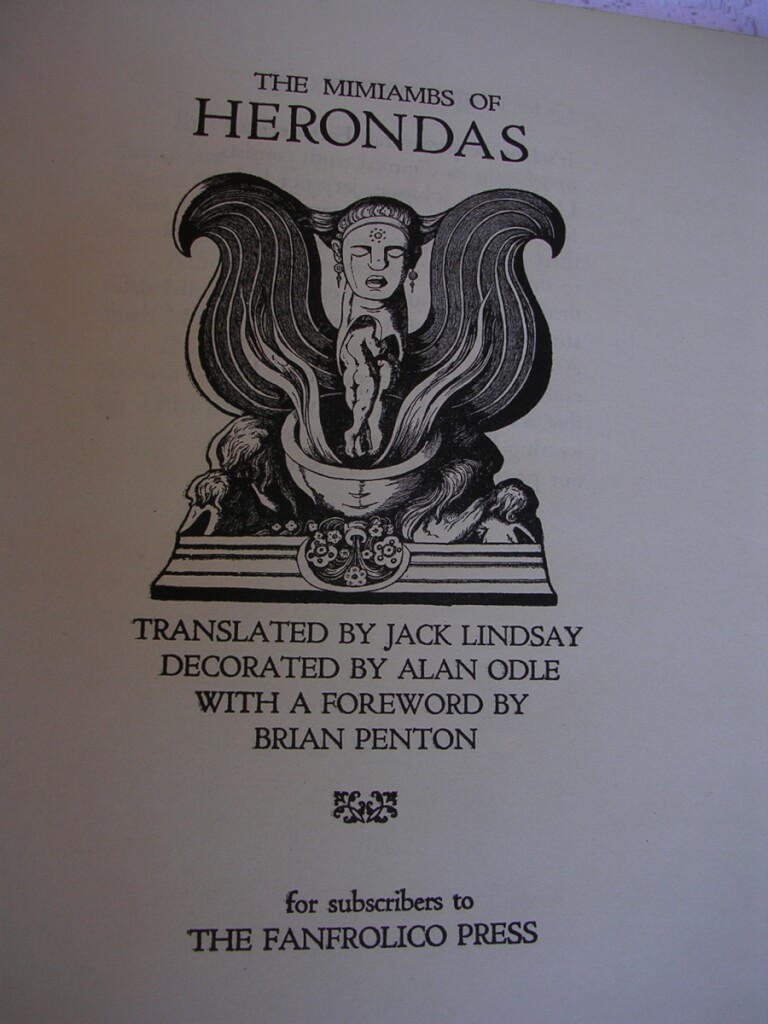 The Mimiambs of Herondas, Herodas, Translated by Jack Lindsay, Decorated by Alan Odle, with a Foreword by Brian Penton. (The Fanfrolico Press, London, nd [c. 1929], #106/375 [first edition, and first Fanfrolico to be printed in London]) 11 7/8" X 9 3/8", unpaginated 72pp, hardbound no DJ, original buckram-backed decorated Japanese paper boards with plain green cloth spine and gilt lettering, top edge gilt, other edges deckle, very good condition minor wear to bottom of boards, Cloister types on Van Gelder Antique handmade paper Herodas was a Greek poet and the author of short humorous dramatic scenes in verse, written under the Alexandrian empire in the 3rd century BC. Mimes were scenes in popular life in South Italy and Sicily, written in the language of the people, vigorous with racy proverbs such as we get in other reflections of that region. The Mimes of Herodas have been known to us only since the discovery and publication of the "Kenyon", M. S. Buck, by the British Museum in 1891 (from a parchment containing 7 legible mimes half of the 8th and a fragment of the 9th). This was Fanfrolico's first London book. It was published "for subscribers to The Franfrolico Press". This new translation of Mimiambs of Herondas was translated by Jack Lindsay and beautifully illustrated by Alan Odle whose grotesque and subversive style was a precursor of surrealism. This is a beautiful printed book in great condition and quite rare. Fanfrolico Press, Australia’s first ‘private press’ in the arts-and-craft tradition, was founded by Jack Lindsay, P. R. Stephensen and John Kirtley, originally in North Sydney in 1923. The press specialized in printings artful, limited editions of classics and forgotten works that were suited to the extravagant style of artist like his father, artist, sculptor and author Norman Lindsay who illustrated many of their books. Fanfrolico was scornful of modernism and with its florid style determinedly backward-looking. They did surprisingly well, despite the lack of business expertise of their young, ambitious "bohemian" owners, eking out a living despite the risky move to London in 1926 and upheavals in ownership that saw the departure in 1927 of Kirtley, and then Stephenson in 1929. Sometime in 1930 they published their last book.
The Mimiambs of Herondas, Herodas, Translated by Jack Lindsay, Decorated by Alan Odle, with a Foreword by Brian Penton. (The Fanfrolico Press, London, nd [c. 1929], #106/375 [first edition, and first Fanfrolico to be printed in London]) 11 7/8" X 9 3/8", unpaginated 72pp, hardbound no DJ, original buckram-backed decorated Japanese paper boards with plain green cloth spine and gilt lettering, top edge gilt, other edges deckle, very good condition minor wear to bottom of boards, Cloister types on Van Gelder Antique handmade paper Herodas was a Greek poet and the author of short humorous dramatic scenes in verse, written under the Alexandrian empire in the 3rd century BC. Mimes were scenes in popular life in South Italy and Sicily, written in the language of the people, vigorous with racy proverbs such as we get in other reflections of that region. The Mimes of Herodas have been known to us only since the discovery and publication of the "Kenyon", M. S. Buck, by the British Museum in 1891 (from a parchment containing 7 legible mimes half of the 8th and a fragment of the 9th). This was Fanfrolico's first London book. It was published "for subscribers to The Franfrolico Press". This new translation of Mimiambs of Herondas was translated by Jack Lindsay and beautifully illustrated by Alan Odle whose grotesque and subversive style was a precursor of surrealism. This is a beautiful printed book in great condition and quite rare. Fanfrolico Press, Australia’s first ‘private press’ in the arts-and-craft tradition, was founded by Jack Lindsay, P. R. Stephensen and John Kirtley, originally in North Sydney in 1923. The press specialized in printings artful, limited editions of classics and forgotten works that were suited to the extravagant style of artist like his father, artist, sculptor and author Norman Lindsay who illustrated many of their books. Fanfrolico was scornful of modernism and with its florid style determinedly backward-looking. They did surprisingly well, despite the lack of business expertise of their young, ambitious "bohemian" owners, eking out a living despite the risky move to London in 1926 and upheavals in ownership that saw the departure in 1927 of Kirtley, and then Stephenson in 1929. Sometime in 1930 they published their last book. -
 Tales and Novels in verse of J. De La Fontaine, illustrated with eighty fives[sic] original plates by Eisen (E.F. Bonaventure, New York, 1883, signed by the publisher, hand-numbered #324/400) 5.75″x9″, 2 vol., xiii+252pp, x+334pp, three-quarter bound with brown morocco with gilt borders over marbled boards, 5 raised bands, gilt titles and decoration on spines, top-edge gilt with others deckled, illustrated throughout with protective tissue guards. Jean de La Fontaine (1621-1695) was a French fabulist and one of the most widely read French poets of the 17th century. After a long period of royal suspicion, he was admitted to the French Academy and his reputation in France has never faded since. Evidence of this is found in the many pictures and statues of the writer, as well as later depictions on medals, coins and postage stamps. The numerous works of La Fontaine fall into three traditional divisions: the Fables, the Tales and the miscellaneous (including dramatic) works. He is best known for the first of these, in which a tradition of fable collecting in French verse reaching back to the Middle Ages was brought to a peak. He published 245 fables, across twelve books between 1668 and 1694, exemplify the grace and wit of his age. Unlike many of his models, his fables function less as didactic tools and more as entertaining art. His beasts, humans, and plants are not merely moral-serving abstractions but rather lively actors in elegantly described escapades. Almost equally as popular in their time, his “tales”, Contes et nouvelles en vers (1665), is an anthology of various ribald short stories and novellas collected and versified from prose. They were particularly marked by their archly licentious tone. La Fontaine drew from several French and Italian works of the 15th and 16th centuries, among them The Decameron of Giovanni Boccaccio, Ludovico Ariosto’s Orlando Furioso, Antoine de la Sale’s collection Cent Nouvelles Nouvelles, and the work of Bonaventure des Périers.
Tales and Novels in verse of J. De La Fontaine, illustrated with eighty fives[sic] original plates by Eisen (E.F. Bonaventure, New York, 1883, signed by the publisher, hand-numbered #324/400) 5.75″x9″, 2 vol., xiii+252pp, x+334pp, three-quarter bound with brown morocco with gilt borders over marbled boards, 5 raised bands, gilt titles and decoration on spines, top-edge gilt with others deckled, illustrated throughout with protective tissue guards. Jean de La Fontaine (1621-1695) was a French fabulist and one of the most widely read French poets of the 17th century. After a long period of royal suspicion, he was admitted to the French Academy and his reputation in France has never faded since. Evidence of this is found in the many pictures and statues of the writer, as well as later depictions on medals, coins and postage stamps. The numerous works of La Fontaine fall into three traditional divisions: the Fables, the Tales and the miscellaneous (including dramatic) works. He is best known for the first of these, in which a tradition of fable collecting in French verse reaching back to the Middle Ages was brought to a peak. He published 245 fables, across twelve books between 1668 and 1694, exemplify the grace and wit of his age. Unlike many of his models, his fables function less as didactic tools and more as entertaining art. His beasts, humans, and plants are not merely moral-serving abstractions but rather lively actors in elegantly described escapades. Almost equally as popular in their time, his “tales”, Contes et nouvelles en vers (1665), is an anthology of various ribald short stories and novellas collected and versified from prose. They were particularly marked by their archly licentious tone. La Fontaine drew from several French and Italian works of the 15th and 16th centuries, among them The Decameron of Giovanni Boccaccio, Ludovico Ariosto’s Orlando Furioso, Antoine de la Sale’s collection Cent Nouvelles Nouvelles, and the work of Bonaventure des Périers. -
 The Romance of Chastisement; or Revelations of the School and Bedroom | by and expert, anonymous (Tremont Publishing Company, Boston, 1876) 8" X 5.5", 150pp, green boards with blindstamp decorations, gilt titles on the spine, red inked edges, just good condition, bumping and chipping on corners and spine, red frame decoration throughout book. The Romance of Chastisement is a Victorian pornographic collection on the theme of flagellation by St George Stock (a probable pseudonym, also credited with The Whippingham Papers). It was originally published by John Camden Hotten in 1866. It was reprinted by William Lazenby in 1883 and again by Charles Carrington in 1902 as The Magnetism of the Rod or the Revelations of Miss Darcy. This is the rare edition published in Boston, USA.
The Romance of Chastisement; or Revelations of the School and Bedroom | by and expert, anonymous (Tremont Publishing Company, Boston, 1876) 8" X 5.5", 150pp, green boards with blindstamp decorations, gilt titles on the spine, red inked edges, just good condition, bumping and chipping on corners and spine, red frame decoration throughout book. The Romance of Chastisement is a Victorian pornographic collection on the theme of flagellation by St George Stock (a probable pseudonym, also credited with The Whippingham Papers). It was originally published by John Camden Hotten in 1866. It was reprinted by William Lazenby in 1883 and again by Charles Carrington in 1902 as The Magnetism of the Rod or the Revelations of Miss Darcy. This is the rare edition published in Boston, USA. -
 Aristophanes: Lysistrata, Aristophanes, illus. by Aubrey Beardsley (Beardsley Press, 1927, one of 750 unnumbered) 8.25″ x 11.5″, 99pp, quarter silver over black cloth, with silver and black patterned endpapers, black lettering to spine, good condition for age, bumping and scraping present, Beardsley’s prints are tipped in. Aristophanes was the greatest writer of ancient Athenian “old comedy,” known for its satires of contemporary life and for its broad, often obscene humor. Lysistrata was first produced in 411 BC, when the Peloponnesian War had been devastating Greece for 20 years. Most people know the plot: Lysistrata assembles women from all of Greece, and they agree that they will not have sex until the men make peace. Aubrey Beardsley was the greatest and the most controversial Art Nouveau illustrator in England, famous for his illustrations of Mallory’s Morte d’Arthur, Oscar Wilde’s Salome, Pope’s The Rape of the Lock, and for several magazines. Because he was associated with Oscar Wilde, Beardsley lost his job as art editor of a magazine named The Yellow Book in 1895, soon after Wilde was arrested for homosexuality. He was approached by Leonard Smithers, a publisher of erotic books, who asked him to illustrate Lysistrata. His illustrations are very much in the spirit of Aristophanes, as funny as they are obscene. Beardsley converted to Catholicism in 1897, and soon after, he asked Smithers to “destroy all copies of Lysistrata” with its “obscene drawings,” but Smithers refused. Beardsley died of tuberculosis in 1898, at the age of 26. Smithers initially published Lysistrata in a limited edition of one hundred copies. It was occasionally reprinted in very small runs, usually clandestinely, often poorly, but copies have long been scarce and expensive. Few copies of Beardsley’s Lysistrata printed before 1966 are currently in circulation. This copy is a rare limited edition printed by the Beardsley Press, London and even rarer with the binding intact.
Aristophanes: Lysistrata, Aristophanes, illus. by Aubrey Beardsley (Beardsley Press, 1927, one of 750 unnumbered) 8.25″ x 11.5″, 99pp, quarter silver over black cloth, with silver and black patterned endpapers, black lettering to spine, good condition for age, bumping and scraping present, Beardsley’s prints are tipped in. Aristophanes was the greatest writer of ancient Athenian “old comedy,” known for its satires of contemporary life and for its broad, often obscene humor. Lysistrata was first produced in 411 BC, when the Peloponnesian War had been devastating Greece for 20 years. Most people know the plot: Lysistrata assembles women from all of Greece, and they agree that they will not have sex until the men make peace. Aubrey Beardsley was the greatest and the most controversial Art Nouveau illustrator in England, famous for his illustrations of Mallory’s Morte d’Arthur, Oscar Wilde’s Salome, Pope’s The Rape of the Lock, and for several magazines. Because he was associated with Oscar Wilde, Beardsley lost his job as art editor of a magazine named The Yellow Book in 1895, soon after Wilde was arrested for homosexuality. He was approached by Leonard Smithers, a publisher of erotic books, who asked him to illustrate Lysistrata. His illustrations are very much in the spirit of Aristophanes, as funny as they are obscene. Beardsley converted to Catholicism in 1897, and soon after, he asked Smithers to “destroy all copies of Lysistrata” with its “obscene drawings,” but Smithers refused. Beardsley died of tuberculosis in 1898, at the age of 26. Smithers initially published Lysistrata in a limited edition of one hundred copies. It was occasionally reprinted in very small runs, usually clandestinely, often poorly, but copies have long been scarce and expensive. Few copies of Beardsley’s Lysistrata printed before 1966 are currently in circulation. This copy is a rare limited edition printed by the Beardsley Press, London and even rarer with the binding intact. -
 Le Hazard du coin du feu, dialogue moral [The Opportunities of the Fireside, a moral dialogue], Crébillon fils (a la Haye, 1763, first edition) 6.25" X 3.75", 260pp, full leather, 5 raised bands and gilt titles on spine and decorating pastedowns, gilt edges, good+ condition, minor bumping to corners, armorial bookplate of Francis John Hughes in front pastedown, Mr. Hughes wrote inside "from the collection of Wallace Stevens. Bought at auction this day 10 March 1959 - FJH" The entire book is a dialogue takes place at Célie's house in a small secluded boudoir and the subject is the deceptions and tricks of debauchery, described through stories, dialogues, and tales by the participants. Claude Prosper Jolyot de Crébillon (1707 – 1777), was a French novelist. He was called "Crébillon fils" to distinguish him from his father, a famous tragedian, Prosper Jolyot de Crébillon. He received a Jesuit education at the elite Lycée Louis-le-Grand. Early on he composed various light works, including plays for the Italian Theatre in Paris, and published a short tale called Le Sylphe in 1730. From 1729 to 1739 he participated in a series of dinners called "Le Caveau" (named after the cabaret where they were held) with other artists, including Alexis Piron, Charles Collé, and Charles Duclos. The publication of Tanzaï et Néadarné, histoire japonaise (1734), which contained thinly veiled attacks on the Papal bull Unigenitus, the cardinal de Rohan and others, landed him briefly in the prison at Vincennes. Publication of Le Sopha, conte moral, an erotic political satire, in 1742 forced him into exile from Paris for several months. Wallace Stevens (1879-1955) was an American modernist poet. He won the Pulitzer Prize for Poetry for his Collected Poems in 1955.
Le Hazard du coin du feu, dialogue moral [The Opportunities of the Fireside, a moral dialogue], Crébillon fils (a la Haye, 1763, first edition) 6.25" X 3.75", 260pp, full leather, 5 raised bands and gilt titles on spine and decorating pastedowns, gilt edges, good+ condition, minor bumping to corners, armorial bookplate of Francis John Hughes in front pastedown, Mr. Hughes wrote inside "from the collection of Wallace Stevens. Bought at auction this day 10 March 1959 - FJH" The entire book is a dialogue takes place at Célie's house in a small secluded boudoir and the subject is the deceptions and tricks of debauchery, described through stories, dialogues, and tales by the participants. Claude Prosper Jolyot de Crébillon (1707 – 1777), was a French novelist. He was called "Crébillon fils" to distinguish him from his father, a famous tragedian, Prosper Jolyot de Crébillon. He received a Jesuit education at the elite Lycée Louis-le-Grand. Early on he composed various light works, including plays for the Italian Theatre in Paris, and published a short tale called Le Sylphe in 1730. From 1729 to 1739 he participated in a series of dinners called "Le Caveau" (named after the cabaret where they were held) with other artists, including Alexis Piron, Charles Collé, and Charles Duclos. The publication of Tanzaï et Néadarné, histoire japonaise (1734), which contained thinly veiled attacks on the Papal bull Unigenitus, the cardinal de Rohan and others, landed him briefly in the prison at Vincennes. Publication of Le Sopha, conte moral, an erotic political satire, in 1742 forced him into exile from Paris for several months. Wallace Stevens (1879-1955) was an American modernist poet. He won the Pulitzer Prize for Poetry for his Collected Poems in 1955. -
Out of stock
 Memoirs of Cardinal Dubois | translated from the French by Ernest Dowson | with photogravure portraits of Cardinal Dubois and the Duc d'Orleans (Leonard Smithers and Co, London, 1899, First Edition thus, first English translation) 9.75"x6.5", 2 volumes, xvi-282pp, viii-268pp, blue boards with gilt decoration and titles on spine, deckled edges, good condition, bumping to corners, bookplates for Reginald Dalton Pontifex in both volumes. According to the publisher, the original manuscript which was written entirely in Dubois hand was stolen by his secretary Lavergne after his death in 1723. It was later discovered of its literary value that Lavergne attempted to sell the manuscript. He was found and arrested. They later fell into the hands of Comte de Maurepas, then upon his death they were passed on to an anonymous writer named Mercier (possibly M. Paul Laroix) whose family had it published in 1829. The manuscript then became lost. In 1899 and English version of the book translated by Ernest Christopher Dowson, was published by the notorious pornographer, Leonard Smithers & Co. This is, presumably a reprinting of that translation. Guillaume Dubois (1656-1723), a son of a country doctor, rose from humble beginnings to positions of power and high honor in government and in the Catholic Church. He is best known for negotiating the Triple Alliance of 1717 between France, the Dutch Republic and Great Britain against their mutual enemy, Spain. Considered one of the four great French Cardinal-Ministers (Richelieu, Mazarin, Dubois, and Fleury). His ecclesiastical career left a great deal to be desired. Although there is no proof of the prevalent assertion that he got secretly married, his licentiousness, and notorious impiety, even at the time of his death, make it evident that he pursued and used ecclesiastical dignities principally to enhance his political position and prestige. Eventually in 1721, Du Bois was created cardinal. He had the reputation of a libertine and adventurer and made plenty of enemies. One of his rivals was charged at creating his portrait, the Duc de Saint-Simon, who was said to have placed a painting of Dubois in his lavatory. Saint-Simon had this to say about the Cardinal: "He was a little, pitiful, wizened, herring-gutted man, in a flaxen wig, with a weasel's face, brightened by some intellect. All the vices - perfidy, avarice, debauchery, ambition, flattery - fought within him for the mastery. He was so consummate a liar that, when taken in the fact, he could brazenly deny it. Even his wit and knowledge of the world were spoiled, and his affected gaiety was touched with sadness, by the odour of falsehood which escaped through every pore of his body." This famous picture is certainly biased. Dubois was unscrupulous, but so were his contemporaries, and whatever vices he had, he forged a European peace that, with the exception of small, restrained military expeditions against the Austrian Habsburgs, would last for a quarter of a century. Leonard Smithers (1861-1907), a solicitor born in Sheffield, was one of the most notable publishers of erotica of his day. He was said to be a brilliant but shady character who operated on the fringes of the rare book trade, issuing small, clandestine editions of risqué books with the boast: 'I will publish the things the others are afraid to touch'. He was notorious for posting a slogan at his bookshop in Bond Street reading "Smut is cheap today". He developed a friendship with Sir Richard Francis Burton and published Burton's famous translation of the Book of One Thousand and One Nights in 1885. He also worked with, among others, Aubrey Beardsley, Aleister Crowley, and Oscar Wilde. With Beardsley and Arthur Symons, he founded The Savoy, a periodical which ran for eight issues in 1896. Smithers famously partnered with Harry Nichols to publish a series of pornographic books under the Erotika Biblion Society imprint. When Beardsley, on his death bed, converted to Catholicism and asked Smithers to “destroy all copies of Lysistrata and bad drawings...by all that is holy all obscene drawings.", Smithers, famously and thankfully ignored him and continued to publish his works until his death in 1907. It was Smithers who published Oscar Wilde's The Ballad of Reading Gaol, a long poem commemorating the harsh rhythms of prison life in 1898. Smithers went bankrupt in 1900 and died impoverished in 1907 from cirrhosis of the liver. Up until his death he continued to sell reproductions (and forgeries) of Beardsley's work as well as reproductions of the Beardsley's letter asking him to destroy his drawings. Reginald Dalton Pontifex (1857–1951) was born in France, attended Magdalen College at Oxford from 1876–80, getting a Fourth in Law in 1880 and a Third in his BCL in 1882. He later practiced as a barrister. At the time of his death it was said he had quite the book collection containing, several of antiquarian interest. He bequethed his book collection to his alma mater. Most of his books were printed in the early nineteenth century and many of them extensively illustrated. He died in Bournemouth, Hampshire, England in 1951.
Memoirs of Cardinal Dubois | translated from the French by Ernest Dowson | with photogravure portraits of Cardinal Dubois and the Duc d'Orleans (Leonard Smithers and Co, London, 1899, First Edition thus, first English translation) 9.75"x6.5", 2 volumes, xvi-282pp, viii-268pp, blue boards with gilt decoration and titles on spine, deckled edges, good condition, bumping to corners, bookplates for Reginald Dalton Pontifex in both volumes. According to the publisher, the original manuscript which was written entirely in Dubois hand was stolen by his secretary Lavergne after his death in 1723. It was later discovered of its literary value that Lavergne attempted to sell the manuscript. He was found and arrested. They later fell into the hands of Comte de Maurepas, then upon his death they were passed on to an anonymous writer named Mercier (possibly M. Paul Laroix) whose family had it published in 1829. The manuscript then became lost. In 1899 and English version of the book translated by Ernest Christopher Dowson, was published by the notorious pornographer, Leonard Smithers & Co. This is, presumably a reprinting of that translation. Guillaume Dubois (1656-1723), a son of a country doctor, rose from humble beginnings to positions of power and high honor in government and in the Catholic Church. He is best known for negotiating the Triple Alliance of 1717 between France, the Dutch Republic and Great Britain against their mutual enemy, Spain. Considered one of the four great French Cardinal-Ministers (Richelieu, Mazarin, Dubois, and Fleury). His ecclesiastical career left a great deal to be desired. Although there is no proof of the prevalent assertion that he got secretly married, his licentiousness, and notorious impiety, even at the time of his death, make it evident that he pursued and used ecclesiastical dignities principally to enhance his political position and prestige. Eventually in 1721, Du Bois was created cardinal. He had the reputation of a libertine and adventurer and made plenty of enemies. One of his rivals was charged at creating his portrait, the Duc de Saint-Simon, who was said to have placed a painting of Dubois in his lavatory. Saint-Simon had this to say about the Cardinal: "He was a little, pitiful, wizened, herring-gutted man, in a flaxen wig, with a weasel's face, brightened by some intellect. All the vices - perfidy, avarice, debauchery, ambition, flattery - fought within him for the mastery. He was so consummate a liar that, when taken in the fact, he could brazenly deny it. Even his wit and knowledge of the world were spoiled, and his affected gaiety was touched with sadness, by the odour of falsehood which escaped through every pore of his body." This famous picture is certainly biased. Dubois was unscrupulous, but so were his contemporaries, and whatever vices he had, he forged a European peace that, with the exception of small, restrained military expeditions against the Austrian Habsburgs, would last for a quarter of a century. Leonard Smithers (1861-1907), a solicitor born in Sheffield, was one of the most notable publishers of erotica of his day. He was said to be a brilliant but shady character who operated on the fringes of the rare book trade, issuing small, clandestine editions of risqué books with the boast: 'I will publish the things the others are afraid to touch'. He was notorious for posting a slogan at his bookshop in Bond Street reading "Smut is cheap today". He developed a friendship with Sir Richard Francis Burton and published Burton's famous translation of the Book of One Thousand and One Nights in 1885. He also worked with, among others, Aubrey Beardsley, Aleister Crowley, and Oscar Wilde. With Beardsley and Arthur Symons, he founded The Savoy, a periodical which ran for eight issues in 1896. Smithers famously partnered with Harry Nichols to publish a series of pornographic books under the Erotika Biblion Society imprint. When Beardsley, on his death bed, converted to Catholicism and asked Smithers to “destroy all copies of Lysistrata and bad drawings...by all that is holy all obscene drawings.", Smithers, famously and thankfully ignored him and continued to publish his works until his death in 1907. It was Smithers who published Oscar Wilde's The Ballad of Reading Gaol, a long poem commemorating the harsh rhythms of prison life in 1898. Smithers went bankrupt in 1900 and died impoverished in 1907 from cirrhosis of the liver. Up until his death he continued to sell reproductions (and forgeries) of Beardsley's work as well as reproductions of the Beardsley's letter asking him to destroy his drawings. Reginald Dalton Pontifex (1857–1951) was born in France, attended Magdalen College at Oxford from 1876–80, getting a Fourth in Law in 1880 and a Third in his BCL in 1882. He later practiced as a barrister. At the time of his death it was said he had quite the book collection containing, several of antiquarian interest. He bequethed his book collection to his alma mater. Most of his books were printed in the early nineteenth century and many of them extensively illustrated. He died in Bournemouth, Hampshire, England in 1951. -
 The Dialogues of Luisa Sigea, Nicolas Chorier, translation by Isadore Liseux (Isadore Liseux, Paris, 1890, first edition, first English translation, printed by Ch. Unsinger) 8.75" X 5.75", 3 books bound in one, xx+87pp, 132pp, 98+2pp, 3/4 crimson morocco over red boards, 5 raised bands, gilt decorations and titles on spine, marbled endpapers, top edge gilt, others deckled. Excellent condition for age, very minor bumping on corners and top and bottom of spine. In six dialogues (I. The skirmish; II. Tribadicon; III. Fabric; IV. The duel; V. Pleasures; VI. Frolics and sports) Tullia, who is 26, initiates her 15 year old cousin, Ottavia, in the art of sexual pleasure. The first four dialogues, which are fairly short, focus on tribadism and defloration. The longer fifth and six dialogues introduce flagellation, contractual submission, group sex, and anal sex. Like many sexual fictions, The Dialogues of Luisa Sigea (originally written in latin "Aloisiae Sigeae Satyra Sotadica de arcanis Amoris et Veneris") attempts to conceal the identity of its author: it purports to be based on a Latin manuscript translation of a work written originally in Spanish in the sixteenth century by an erudite young woman, Luisa Sigea of Toledo and translated into latin by Jean Meursius of Holland. In fact, it was written c. 1660, in latin, by a Frenchman, Nicolas Chorier (1612-1692), a lawyer who wrote works on various historical and philosophical subjects. The first first French translation, L’Academie des dames, was issued in the 1680. This 1890 edition was for the first time translated into English by Isidore Liseux and issued as a 3 volume set. (1. I-IV, 2. V, 3. VI). Isidore Liseux (1835-1894) was a French bibliophile and publisher of erotica and curiosa. His publications were mostly rare texts of 16th to 18th century authors, hard to find and little known books which were usually translated and annotated by his friend and associate Alcide Bonneau or by Liseux himself. Liseux and Bonneau, both ex-priests, knew each other since seminary. His books were published in small numbers, on high quality paper, and with excellent typography. His usual printers were Claude Motteroz, Antoine Bécus, and later Charles Unsinger. Liseux's books were published openly as the climate was more permissive in Paris at the time. His books were so well regarded that pirates of his books and even unrelated books bearing his imprint with a false date were published clandestinely into the 20th century. French poet, Guillaume Apollinaire wrote: "The publications of Liseux are more and more sought after because they are correct, beautiful and rare." (Le flaneur des deux rives, 1918).
The Dialogues of Luisa Sigea, Nicolas Chorier, translation by Isadore Liseux (Isadore Liseux, Paris, 1890, first edition, first English translation, printed by Ch. Unsinger) 8.75" X 5.75", 3 books bound in one, xx+87pp, 132pp, 98+2pp, 3/4 crimson morocco over red boards, 5 raised bands, gilt decorations and titles on spine, marbled endpapers, top edge gilt, others deckled. Excellent condition for age, very minor bumping on corners and top and bottom of spine. In six dialogues (I. The skirmish; II. Tribadicon; III. Fabric; IV. The duel; V. Pleasures; VI. Frolics and sports) Tullia, who is 26, initiates her 15 year old cousin, Ottavia, in the art of sexual pleasure. The first four dialogues, which are fairly short, focus on tribadism and defloration. The longer fifth and six dialogues introduce flagellation, contractual submission, group sex, and anal sex. Like many sexual fictions, The Dialogues of Luisa Sigea (originally written in latin "Aloisiae Sigeae Satyra Sotadica de arcanis Amoris et Veneris") attempts to conceal the identity of its author: it purports to be based on a Latin manuscript translation of a work written originally in Spanish in the sixteenth century by an erudite young woman, Luisa Sigea of Toledo and translated into latin by Jean Meursius of Holland. In fact, it was written c. 1660, in latin, by a Frenchman, Nicolas Chorier (1612-1692), a lawyer who wrote works on various historical and philosophical subjects. The first first French translation, L’Academie des dames, was issued in the 1680. This 1890 edition was for the first time translated into English by Isidore Liseux and issued as a 3 volume set. (1. I-IV, 2. V, 3. VI). Isidore Liseux (1835-1894) was a French bibliophile and publisher of erotica and curiosa. His publications were mostly rare texts of 16th to 18th century authors, hard to find and little known books which were usually translated and annotated by his friend and associate Alcide Bonneau or by Liseux himself. Liseux and Bonneau, both ex-priests, knew each other since seminary. His books were published in small numbers, on high quality paper, and with excellent typography. His usual printers were Claude Motteroz, Antoine Bécus, and later Charles Unsinger. Liseux's books were published openly as the climate was more permissive in Paris at the time. His books were so well regarded that pirates of his books and even unrelated books bearing his imprint with a false date were published clandestinely into the 20th century. French poet, Guillaume Apollinaire wrote: "The publications of Liseux are more and more sought after because they are correct, beautiful and rare." (Le flaneur des deux rives, 1918). -
 The Lysistrata of Aristophanes | Wholly translated into English and illustrated with eight full-page drawings by Aubrey Beardsley with a preface on Aristophanic Comedy and its reflection in the art of the Illustrator by George Frederic Lees, Aristophanes, illus. by Aubrey Beardsley, forward by George Frederic Lees (Privately Printed in Paris, 1931, #352/525) 11.25" X 9.25", 61pp, loosely bound with loose cover, with original slip-case, printed on hand-made Van Gelder paper, 8 illustrations printed on mould-made Annoy Paper, interior pages clean and in fine condition, slip-case is in poor condition, some soiling on the cover. Aristophanes was the greatest writer of ancient Athenian “old comedy,” known for its satires of contemporary life and for its broad, often obscene humor. Lysistrata was first produced in 411 BC, when the Peloponnesian War had been devastating Greece for 20 years. Most people know the plot: Lysistrata assembles women from all of Greece, and they agree that they will not have sex until the men make peace. Aubrey Beardsley was the greatest and the most controversial Art Nouveau illustrator in England, famous for his illustrations of Mallory’s Morte d’Arthur, Oscar Wilde’s Salome, Pope’s The Rape of the Lock, and for several magazines. Because he was associated with Oscar Wilde, Beardsley lost his job as art editor of a magazine named The Yellow Book in 1895, soon after Wilde was arrested for homosexuality. He was approached by Leonard Smithers, a publisher of erotic books, who asked him to illustrate Lysistrata. His illustrations are very much in the spirit of Aristophanes, as funny as they are obscene. Beardsley converted to Catholicism in 1897, and soon after, he asked Smithers to “destroy all copies of Lysistrata” with its “obscene drawings,” but Smithers refused. Beardsley died of tuberculosis in 1898, at the age of 26. Smithers initially published Lysistrata in a limited edition of one hundred copies. It was occasionally reprinted in very small runs, usually clandestinely, often poorly, but copies have long been scarce and expensive. I have only found this copy a few places outside of museums and libraries. This is a rare fine reproduction of the original drawings on quality paper. I do not have information about the actual publisher.
The Lysistrata of Aristophanes | Wholly translated into English and illustrated with eight full-page drawings by Aubrey Beardsley with a preface on Aristophanic Comedy and its reflection in the art of the Illustrator by George Frederic Lees, Aristophanes, illus. by Aubrey Beardsley, forward by George Frederic Lees (Privately Printed in Paris, 1931, #352/525) 11.25" X 9.25", 61pp, loosely bound with loose cover, with original slip-case, printed on hand-made Van Gelder paper, 8 illustrations printed on mould-made Annoy Paper, interior pages clean and in fine condition, slip-case is in poor condition, some soiling on the cover. Aristophanes was the greatest writer of ancient Athenian “old comedy,” known for its satires of contemporary life and for its broad, often obscene humor. Lysistrata was first produced in 411 BC, when the Peloponnesian War had been devastating Greece for 20 years. Most people know the plot: Lysistrata assembles women from all of Greece, and they agree that they will not have sex until the men make peace. Aubrey Beardsley was the greatest and the most controversial Art Nouveau illustrator in England, famous for his illustrations of Mallory’s Morte d’Arthur, Oscar Wilde’s Salome, Pope’s The Rape of the Lock, and for several magazines. Because he was associated with Oscar Wilde, Beardsley lost his job as art editor of a magazine named The Yellow Book in 1895, soon after Wilde was arrested for homosexuality. He was approached by Leonard Smithers, a publisher of erotic books, who asked him to illustrate Lysistrata. His illustrations are very much in the spirit of Aristophanes, as funny as they are obscene. Beardsley converted to Catholicism in 1897, and soon after, he asked Smithers to “destroy all copies of Lysistrata” with its “obscene drawings,” but Smithers refused. Beardsley died of tuberculosis in 1898, at the age of 26. Smithers initially published Lysistrata in a limited edition of one hundred copies. It was occasionally reprinted in very small runs, usually clandestinely, often poorly, but copies have long been scarce and expensive. I have only found this copy a few places outside of museums and libraries. This is a rare fine reproduction of the original drawings on quality paper. I do not have information about the actual publisher.











